Moon Alphabet - K-R
Introduction | K | L | M | N | O | P | Q | R | References
On these pages I do "moon walks" on the basis of my own photos. In other words, I try to name the objects on my lunar photos to get to know the moon better. Maybe these pages will help others to get to know the moon better as well...
On this and further pages, I present selected surface elements (maria, craters, mountains) on the moon, or combinations of these in alphabetical order, thus, as a small "moon encyclopedia." Some of the photos are repeated because they contain several interesting objects; the current objects are labelled in yellow. The photos are rotated by 180 degrees or mirrored so that they correspond to the normal visual impression, but they are often somewhat skewed. I hope to be able to replace some photos with better ones in the course of time...
Notes
- The initial selection of objects was guided by Lambert Spix' book "moonscout," but probably more elements will be added some day...
- The description of the general elements of the moon surface can be found on page Walking the Moon with my own Photos - Overview.
- See also pages Moon Alphabet - A-C, Moon Alphabet - D-J, Moon Alphabet - S-Z - Back to the overview of my "moon walks".
Sources
- Spix = Lambert Spix (2013, 3. Auflage). moonscout - Mondmeere, Krater und Gebirge einfach finden und beobachten
- S&G = Lambert Spix & Frank Gasparini (2011, 1. Auflage). Der Moonhopper
- VMA = Virtual Moon Atlas
For more information see the references.
Introduction
On this page and on a second one, I present landscapes on the moon, surface elements (maria, craters, mountains), or combinations of these in alphabetical order, thus, as a small "moon encyclopedia." The photos are rotated by 180 degrees or mirrored so that they correspond to the normal visual impression, but they are often somewhat skewed.
Note: The description of the general elements of the moon surface can be found on page Walking the Moon with my own Photos - Overview.
K
Kepler
Kepler is a small crater with a diameter of 30 km, but a depthe of 3000 m (Spix; 31 km and 2750 m according to VMA). Around the full moon the crater is surrounded by a ring of bright ejected materials.
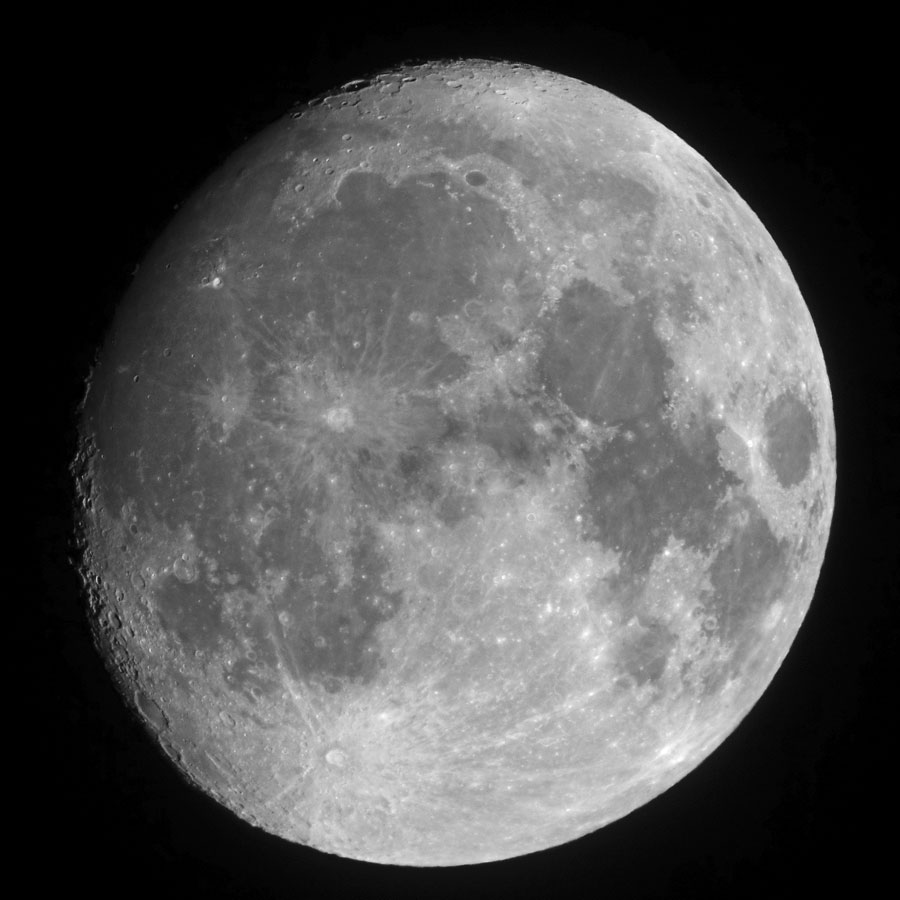 |
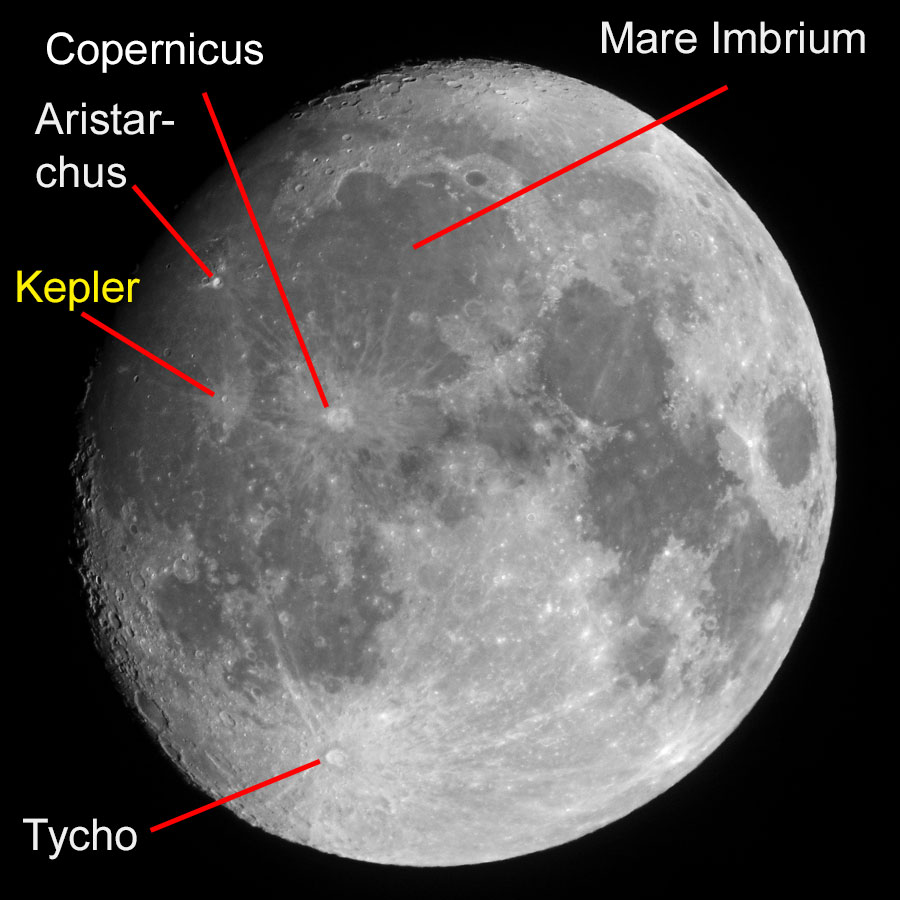 |
|
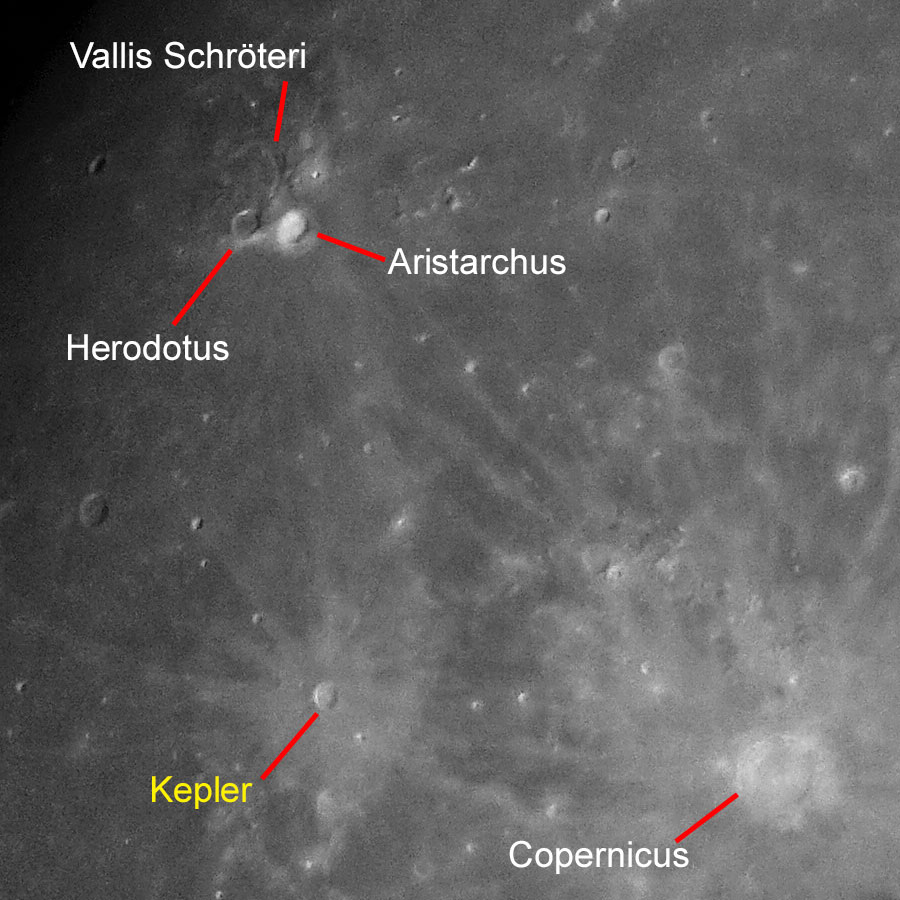 |
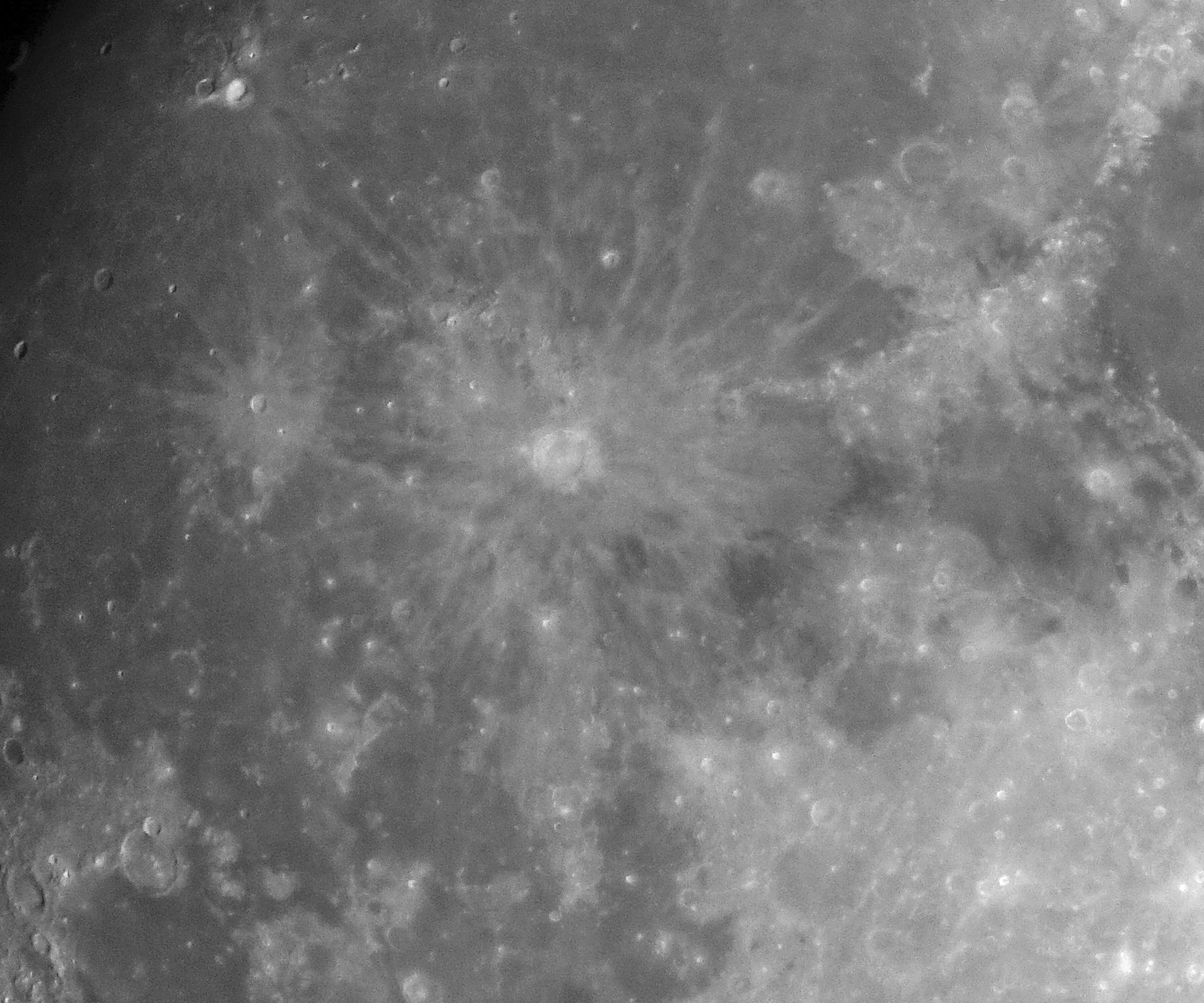 |
|
Section from the photo above |
Section from the photo above |
Photo data: November 20, 2018, Omegon PS 72/432 refractor, Sony RX100 M4 attached to the 32 mm Digiscope eyepiece, 3 x focal extender (40.5 x)
L
Langrenus
The ring mountains (large crater) Langrenus has a diameter of 132 km and a depth of 4500 m (Spix; 133 km and 2600 m altitude according to VMA); it is located at the eastern edge of Mare Fecunditatis (Sea of Fertility).
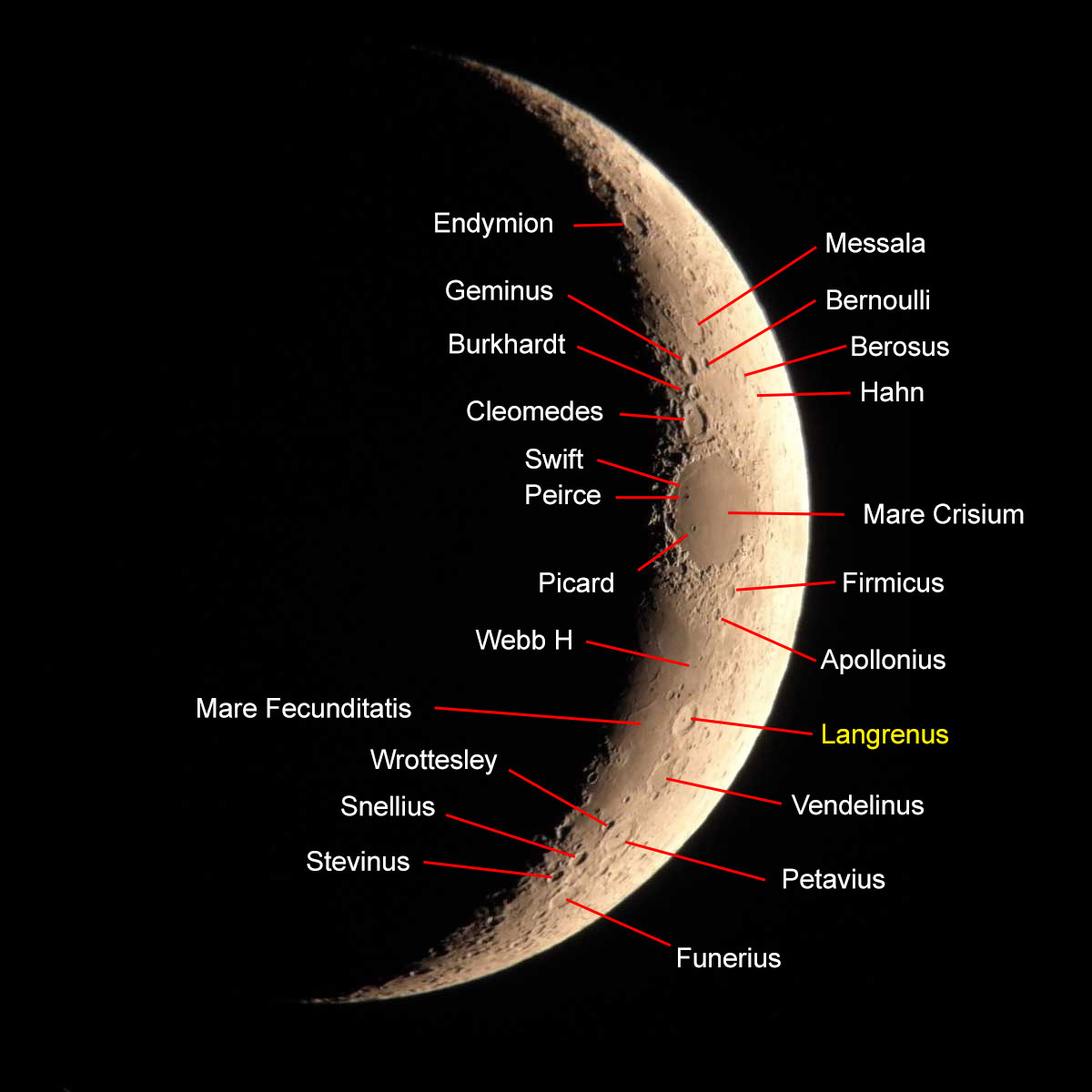 |
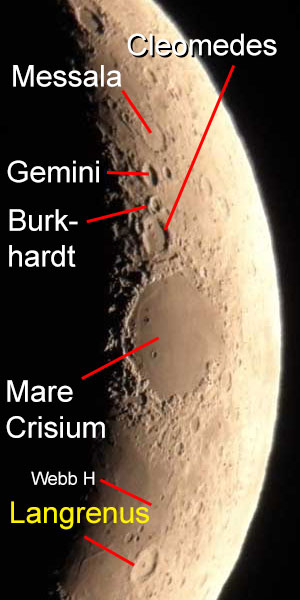 |
Photo data: April 10, 2016, GSO GSD 680 telescope, Leica X Vario mounted fix to 32 mm DigiScope eyepiece
Longomontanus
The walled plain Longomontanus has a diameter of 164 km (VMA) and is located in the south of the moon, south of crater Tycho.
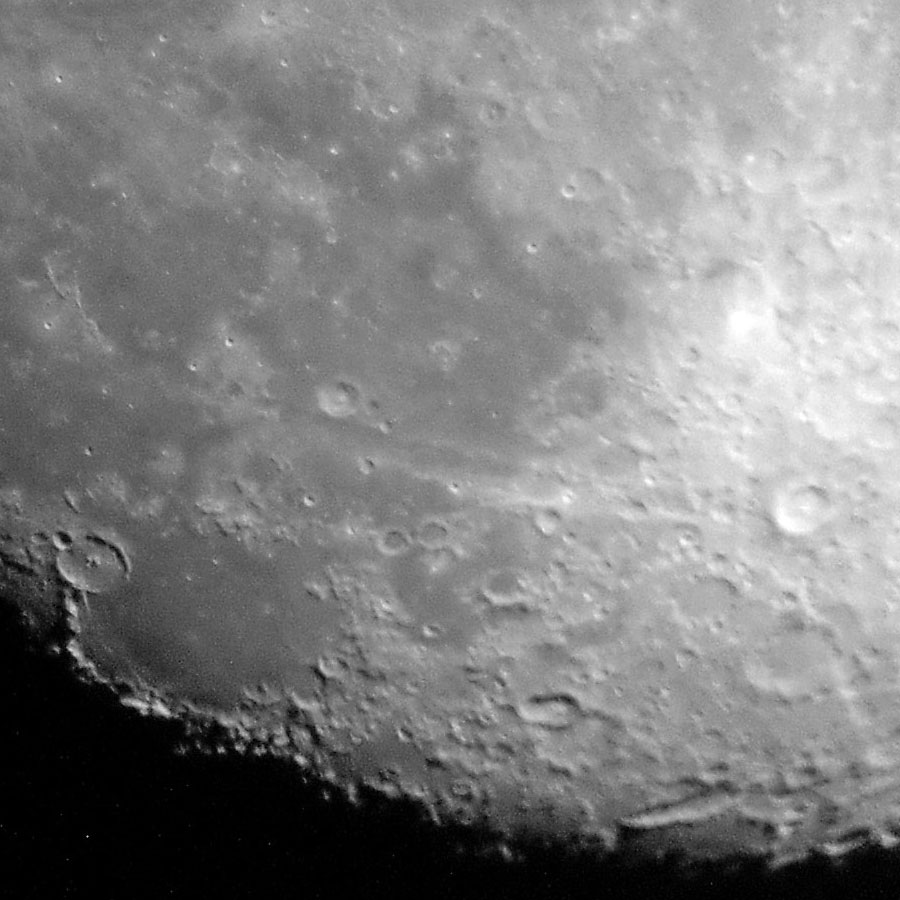 |
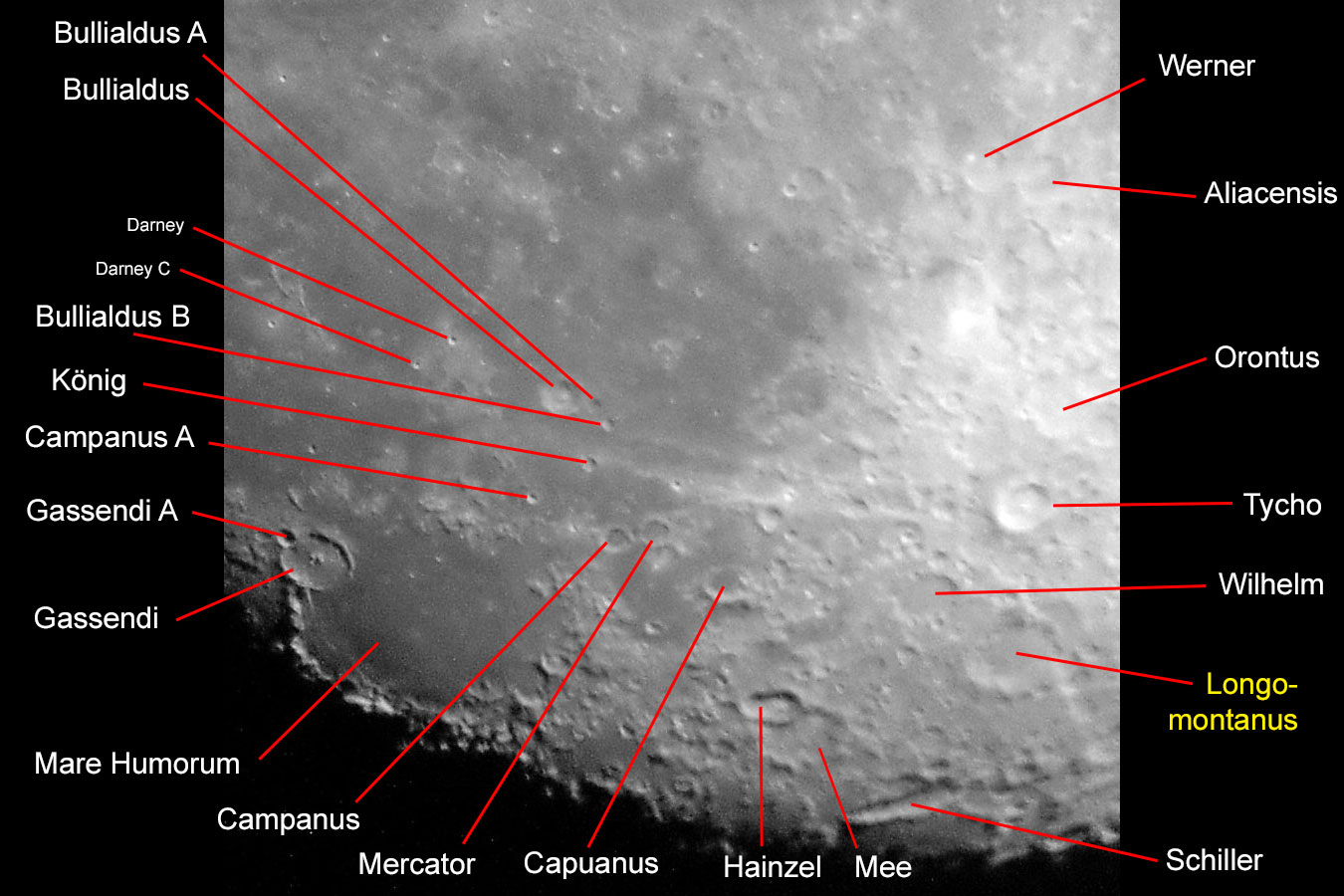 |
Photo data: February 26, 2018, Sky-Watcher Skymax-102 OTA, Ricoh GR held to the eyepiece
M
Maurolycus
The walled plain (large crater) Maurolycus has a diameter of 115 km and a depth of 4700 m (Spix; 114 km according to Virtual Moon Atlas); it is located in the southern part of the moon (far down...).
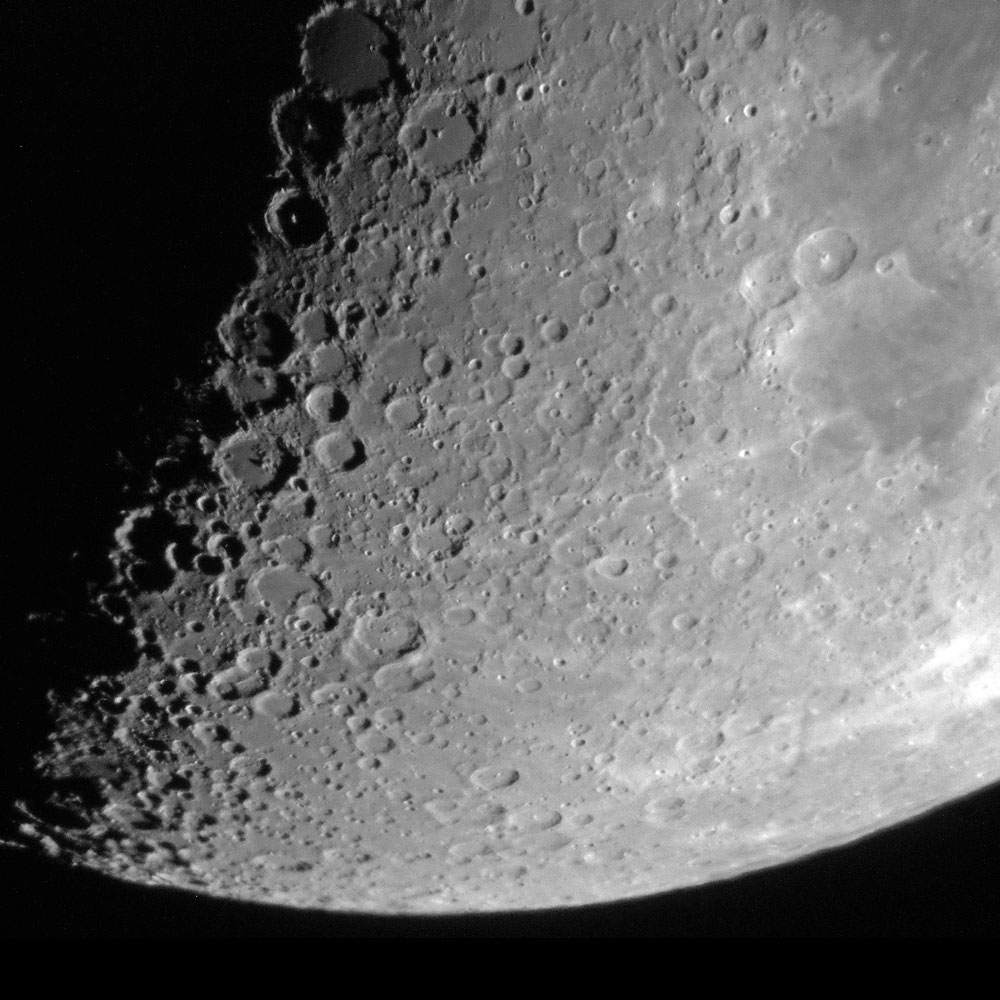 |
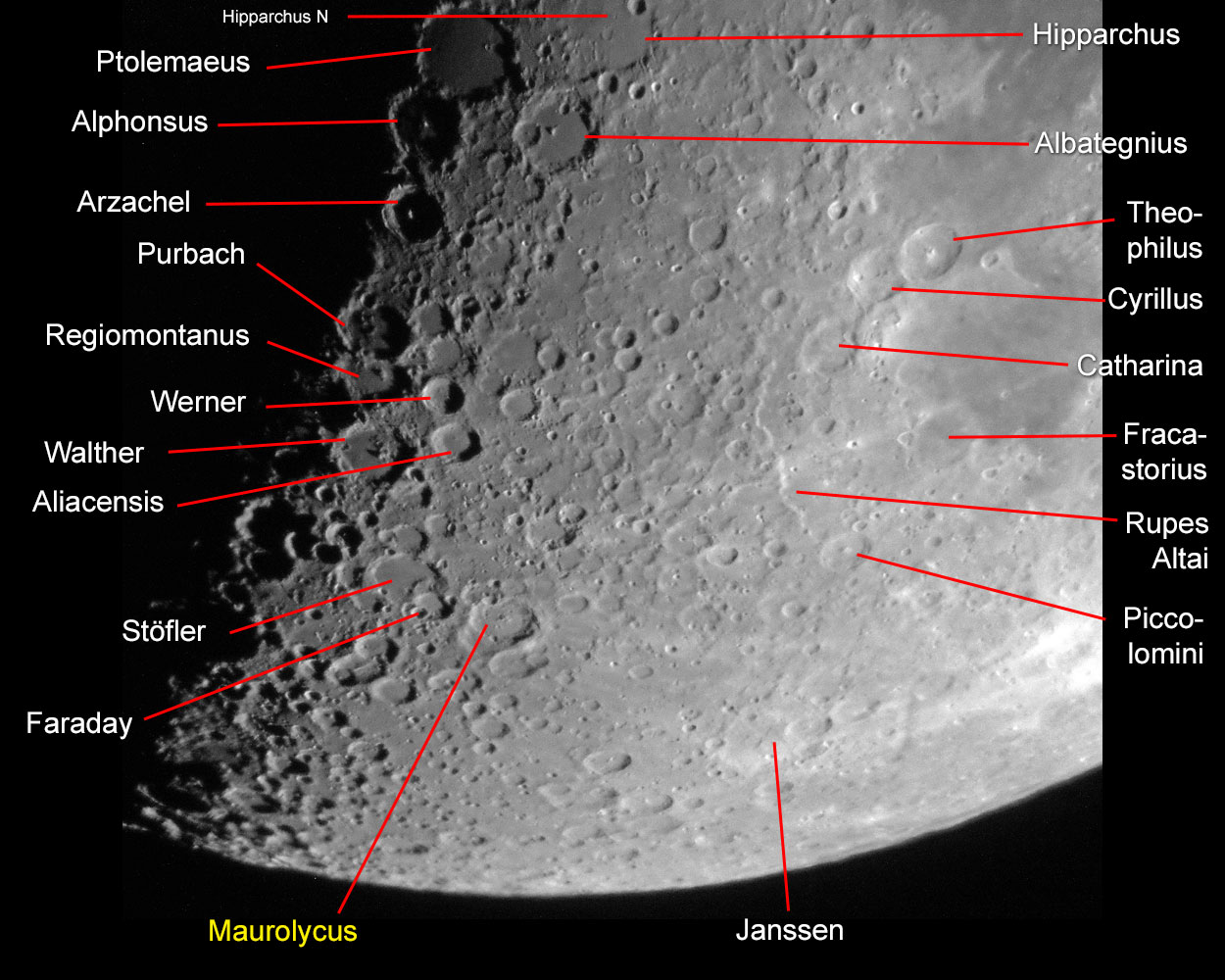 |
Photo data: March 24, 2018, Sky-Watcher Explorer 150PDS telescope, Ricoh GR held to the eyepiece
Mawson, Dorsa (Mawson Ridges)
Dorsa Mawson is a group of ridges in Mare Fecunditatis and is approximately 140 km long (S&G).
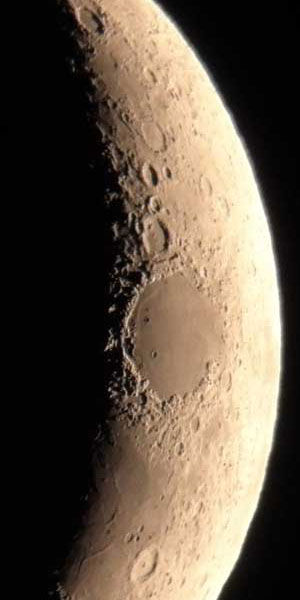 |
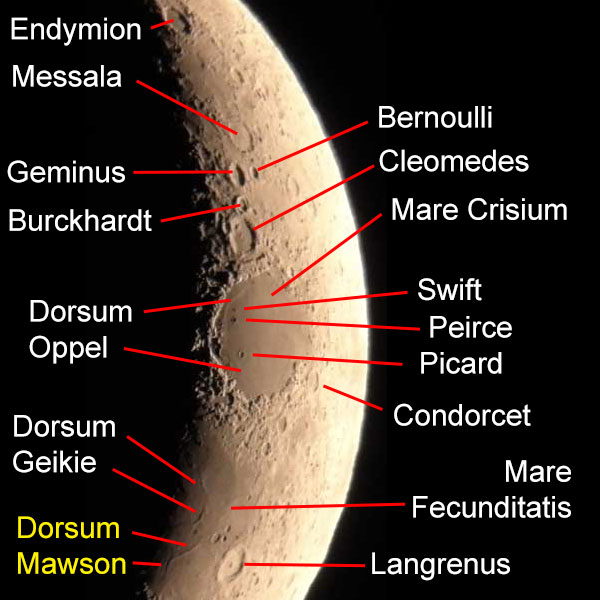 |
Photo data: April 10, 2016, GSO GSD 680 telescope, Leica X Vario mounted fix to 32 mm DigiScope eyepiece
N
Nectaris (Sea of Nectars)
Mare Nectaris (Sea of Nectars) has a diameter of 340 km (Spix).
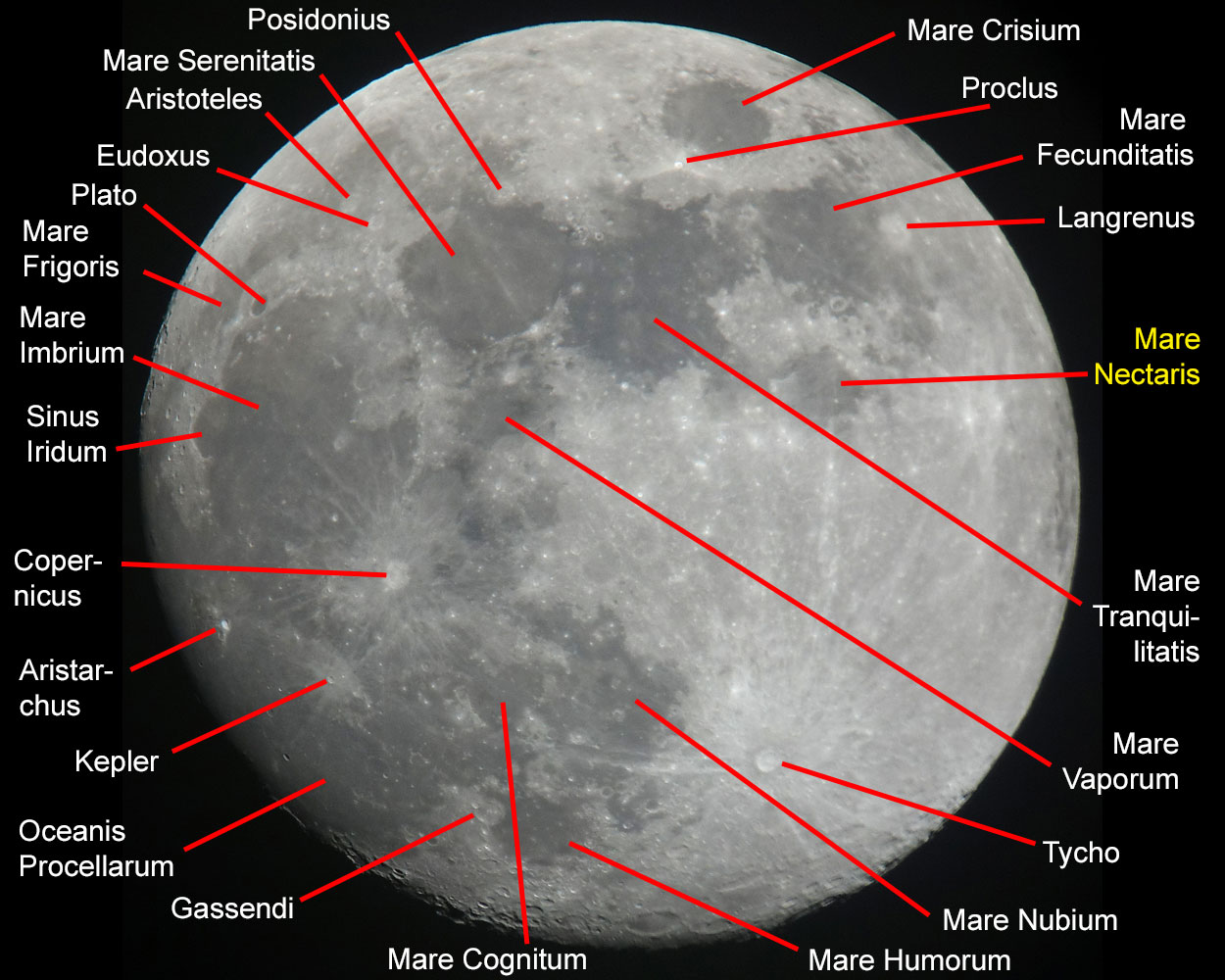 |
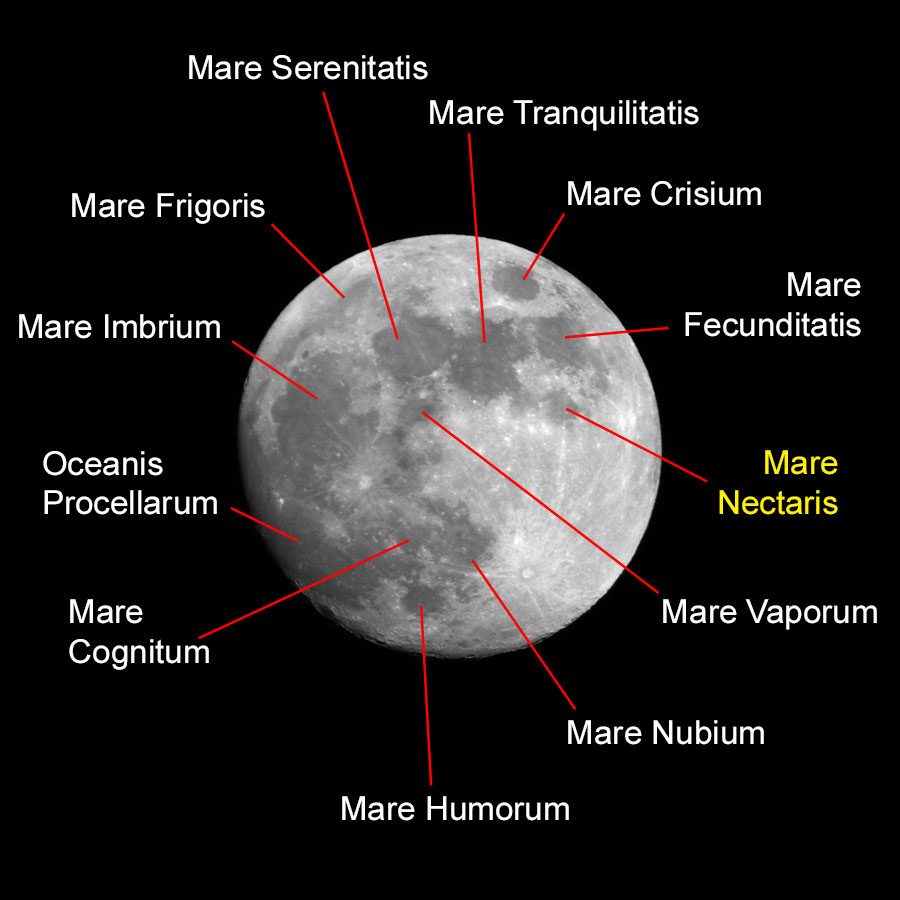 |
Photo data (left photo): March 29, 2018 (two days before Full Moon), Sky-Watcher
Skymax-127 OTA, Sony RX100 M4 attached to the 32 mm eyepiece
Photo data (right photo): February 28, 2010 (nearly Full Moon), Sky-Watcher
Skymax-127 OTA (probably), Leica X Vario (36 - 50 mm equiv.) held to a 32 mm
eyepiece (47 x)
Nubium, Mare (Sea of Clouds)
Mare Nubium (Sea of Clouds) has a diameter of 715 km (Spix).
 |
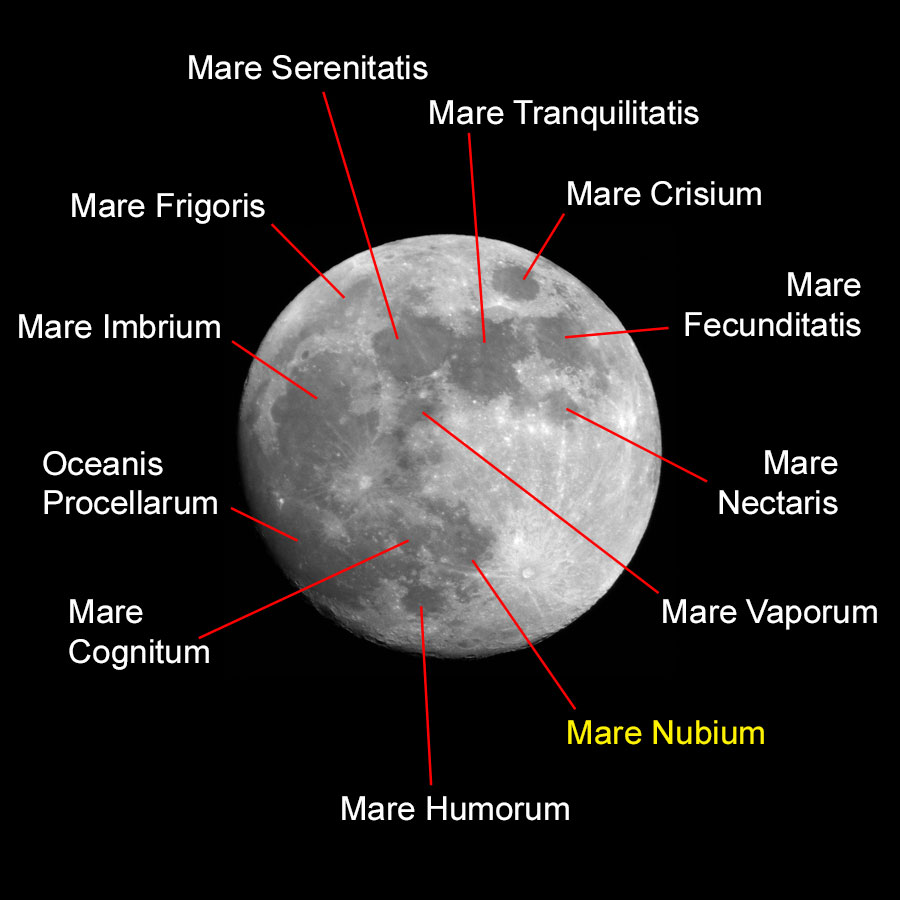 |
Photo data (left photo): March 29, 2018 (two days before Full Moon), Sky-Watcher
Skymax-127 OTA, Sony RX100 M4 attached to the 32 mm eyepiece
Photo data (right photo): February 28, 2010 (nearly Full Moon), Sky-Watcher
Skymax-127 OTA (probably), Leica X Vario (36 - 50 mm equiv.) held to a 32 mm
eyepiece (47 x)
O
Oppel, Dorsum (Oppel Ridge)
Dorsum Oppel, that is, the ridge Oppel, is located at the western edge of the Mare Crisium and is 300 km long and 100 m high (S&G). According to Spix & Gasparini it is best seen in the 3rd night after new moon.
 |
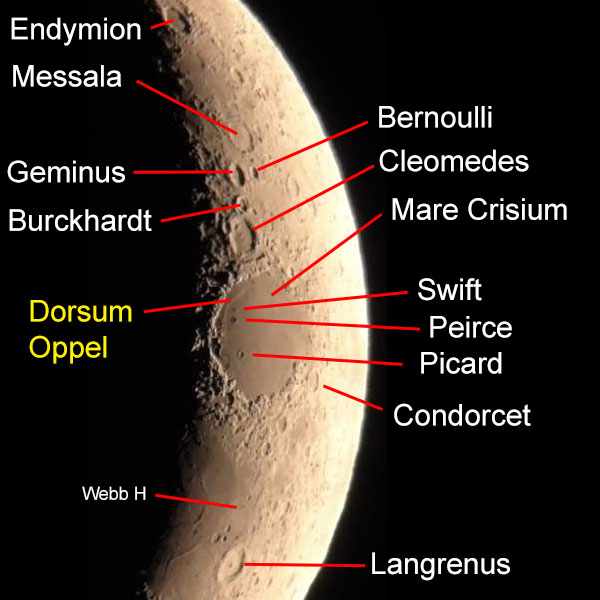 |
Photo data: April 10, 2016, GSO GSD 680 telescope, Leica X Vario mounted fix to 32 mm DigiScope eyepiece
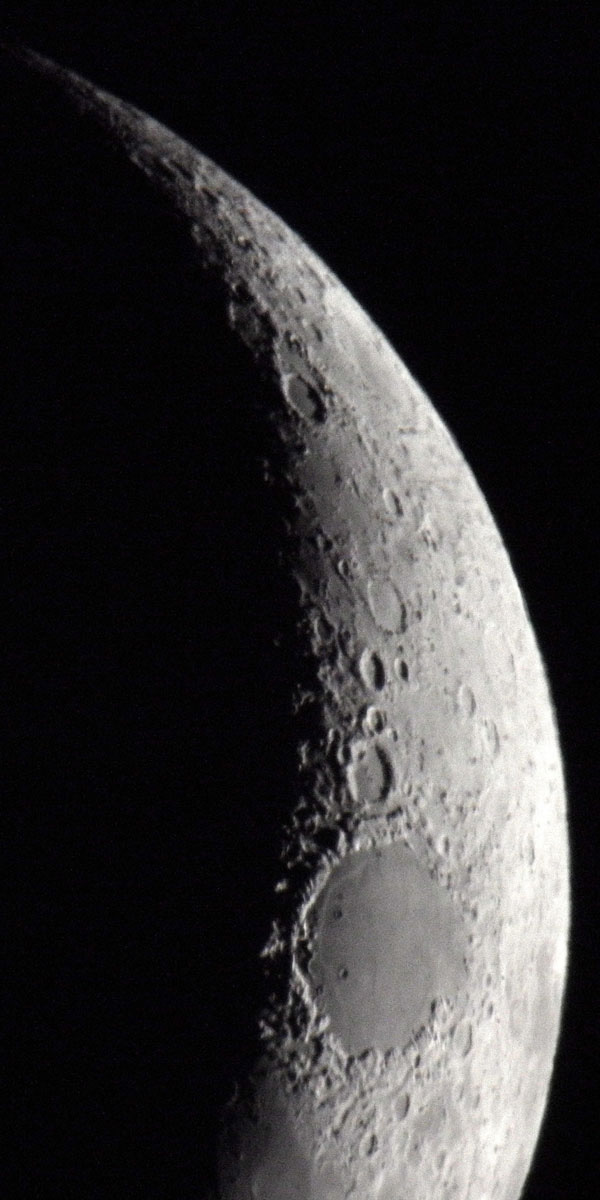 |
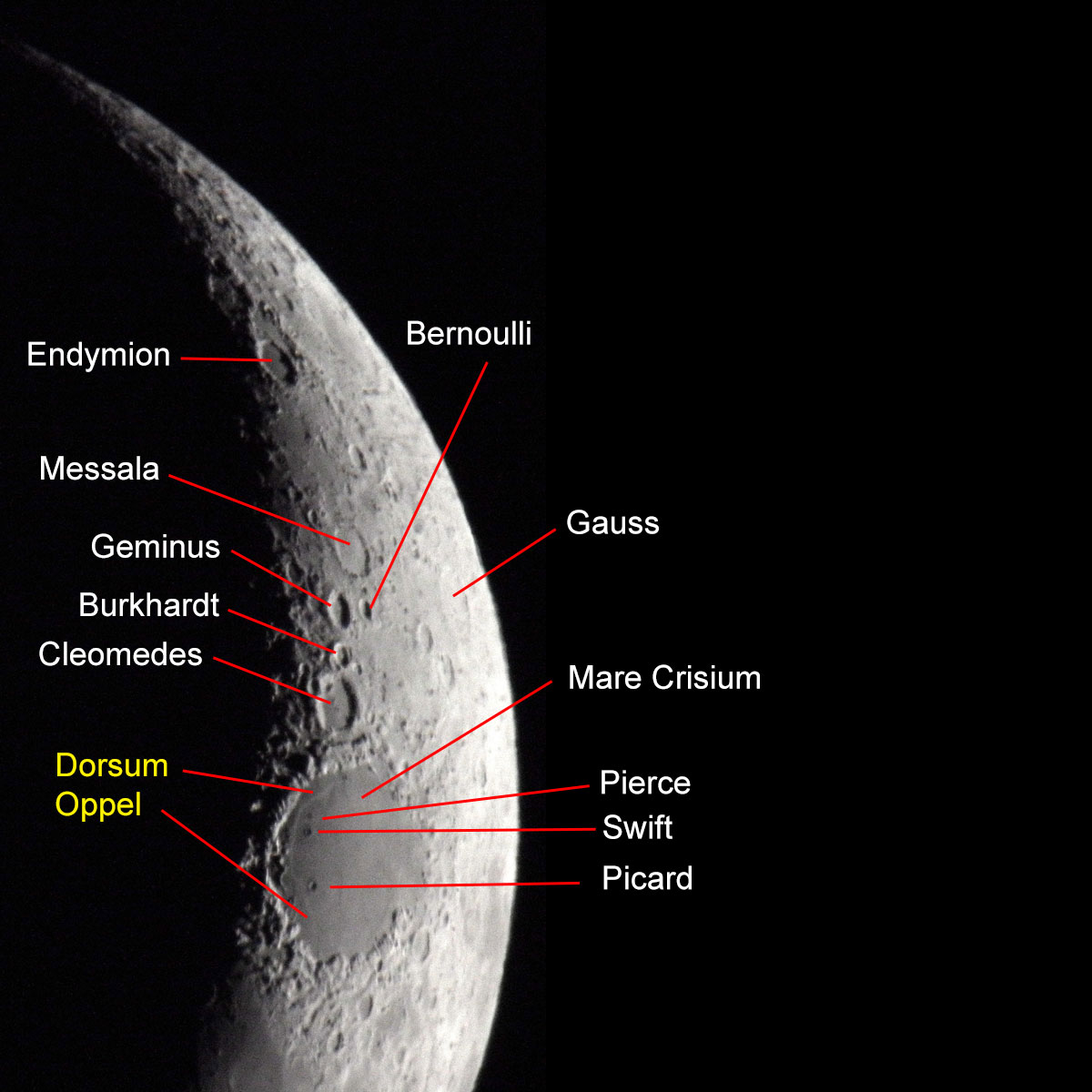 |
Photo data: April 10, 2016, GSO GSD 680 telescope, Leica X Vario held to the 16 mm UWA eyepiece
P
Petavius
The ring mountains (large crater) Petavius has a diameter of 188 km and a depth of 3300 m (Spix; 177 km and 3300 m altitude according to VMA); it is located at the southeastern edge of the moon.
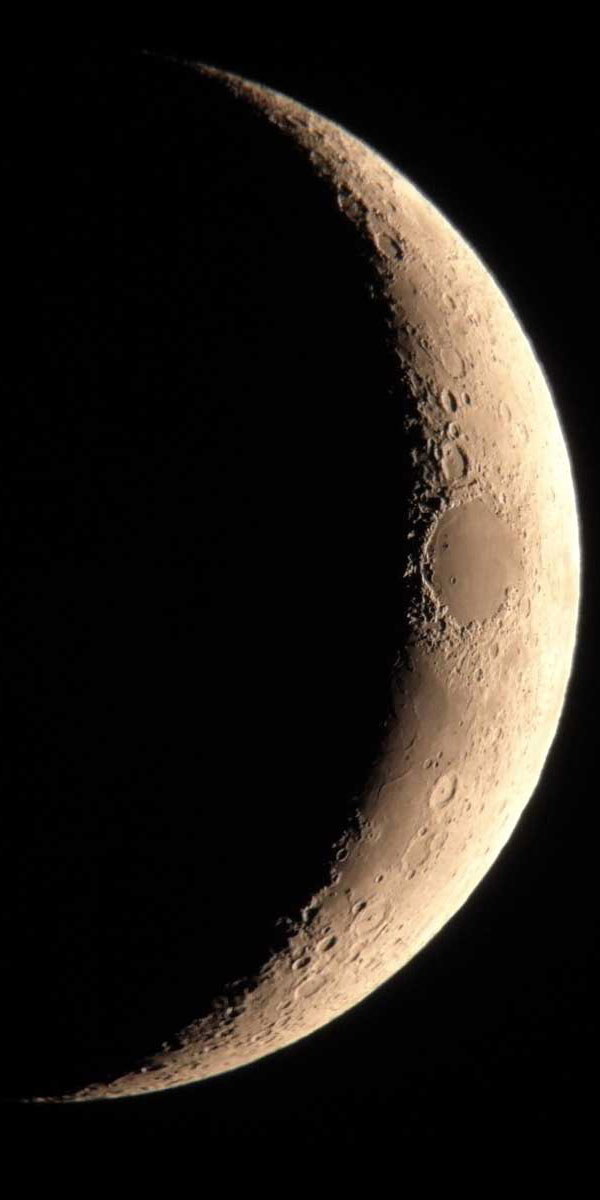 |
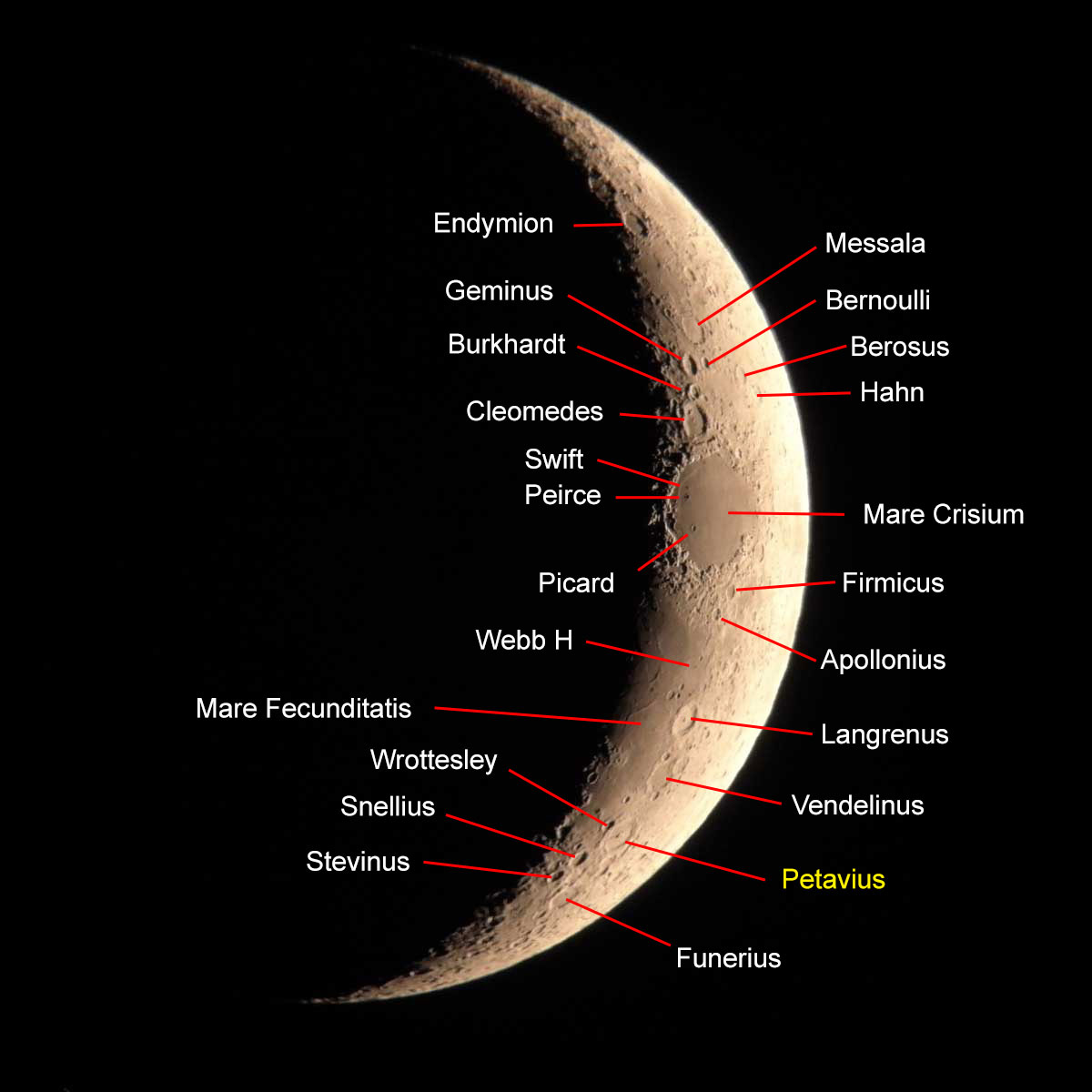 |
Photo data: April 10, 2016, GSO GSD 680 telescope, Leica X Vario mounted fix to 32 mm DigiScope eyepiece
Piccolomini
The ring mountains Piccolomini has a diameter of 87 km and is 4200 m deep (S&G; 88 km and 4500 m according to VMA). To the north of Piccolomini, you will find a ring of small craters called the "telephone dial."
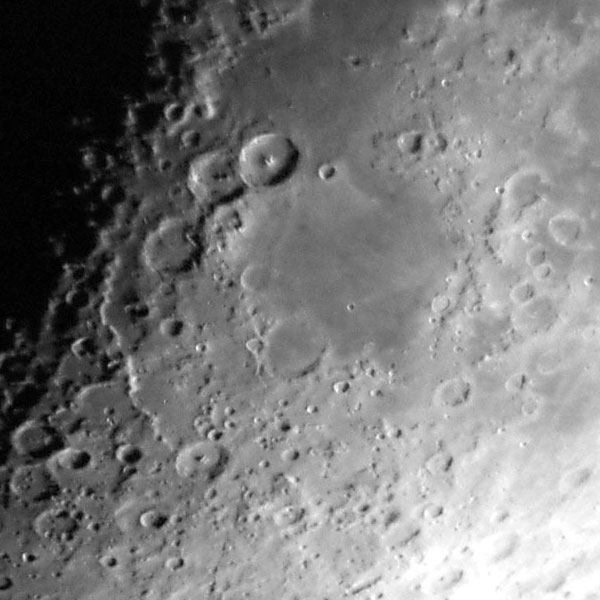 |
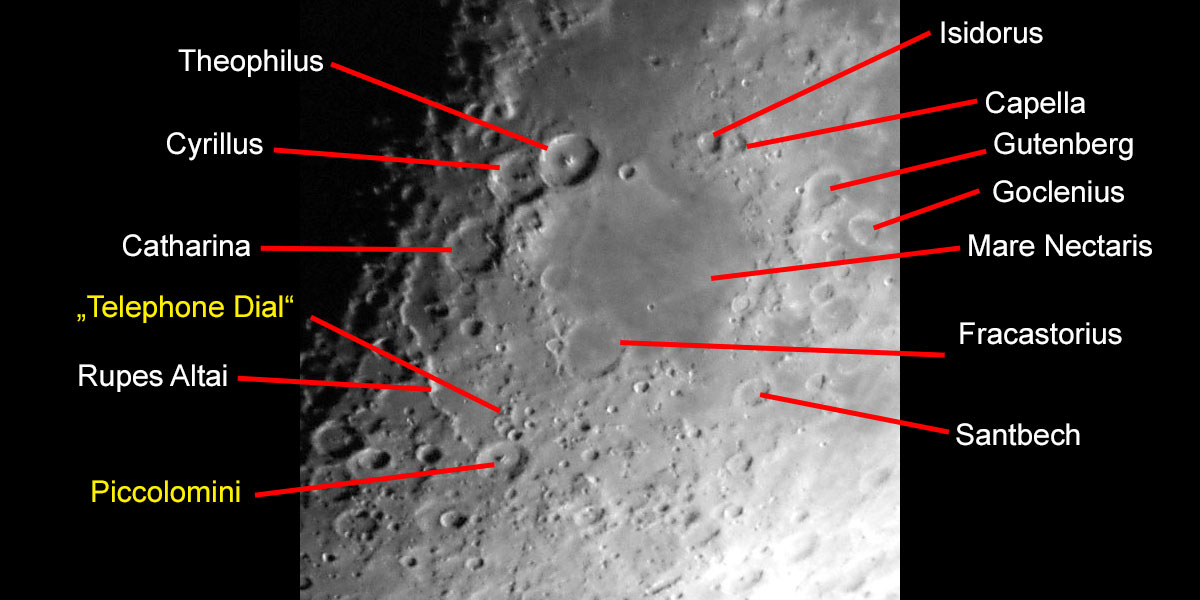 |
|
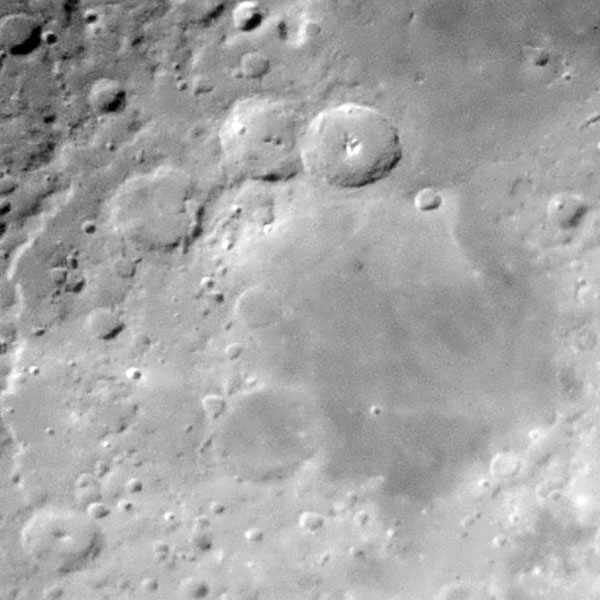 |
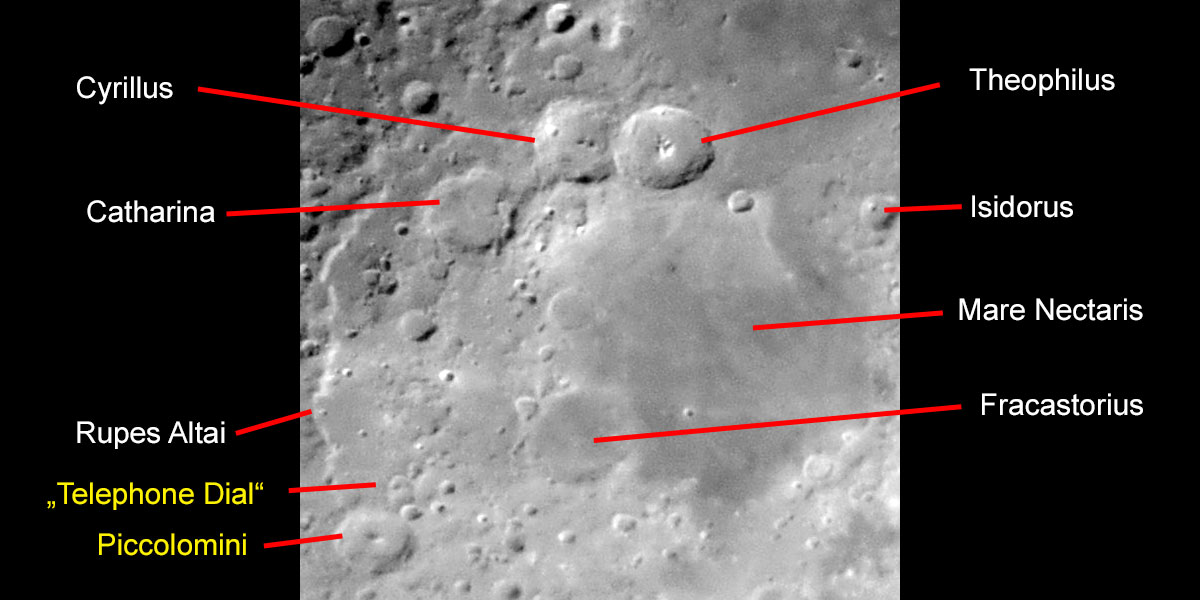 |
Photo data: April 2-3, 2017, Sky-Watcher Explorer 150PDS, Ricoh GR held to the 7 mm UWA eyepiece
Pico, Mons
The 2400 m high isolated mountain Mons Pico (S&G, VMA) is located left (west) of the crater Cassini in the northern part of Mare Imbrium (Sea of Rain).
 |
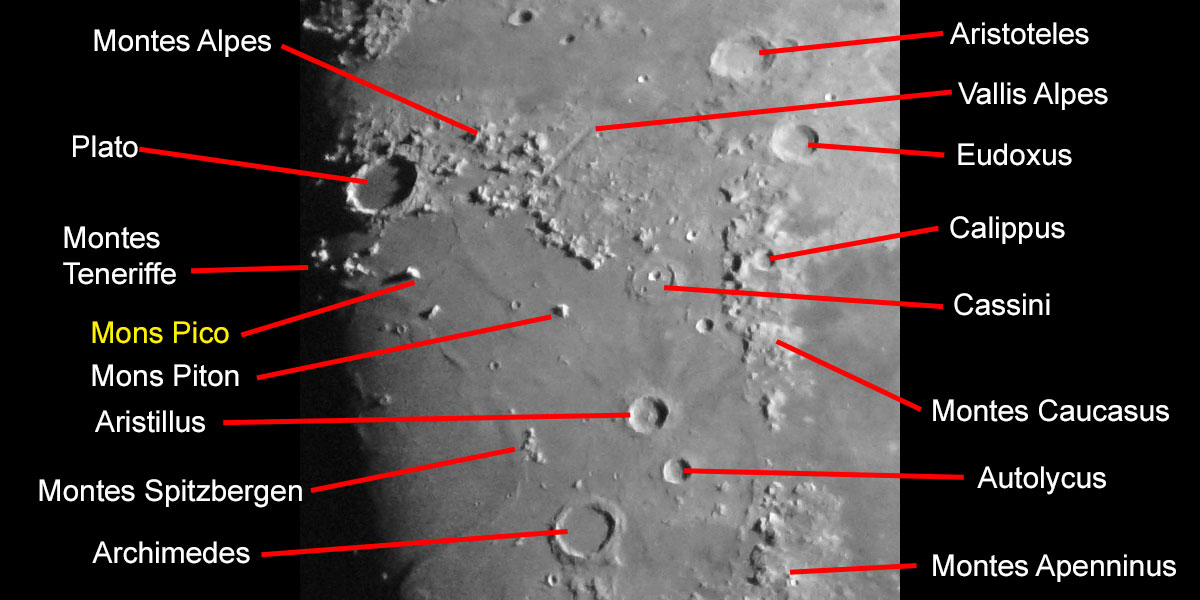 |
Photo data: March 25, 2018, Sky-Watcher Skymax-127 OTA, Sony RX100 M4 attached to the eyepiece
Piton, Mons
The 2250 m high isolated mountain Mons Piton (S&G, VMA) lies southeast of the crater Plato in the northern part of Mare Imbrium (Sea of Rain).
 |
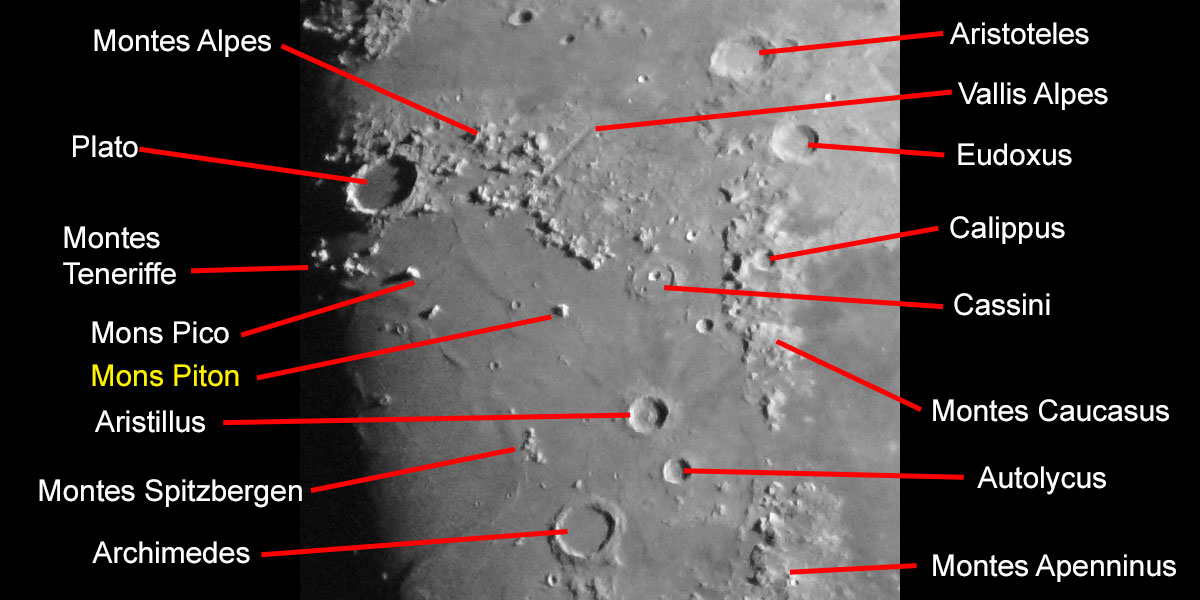 |
Photo data: March 25, 2018, Sky-Watcher Skymax-127 OTA, Sony RX100 M4 attached to the eyepiece
Plato
The walled plain (large crater) Plato has a diameter of 100 km and a depth of 2100 m (Spix; 101 km according to VMA); it is located at the northern edge of Mare Imbrium.
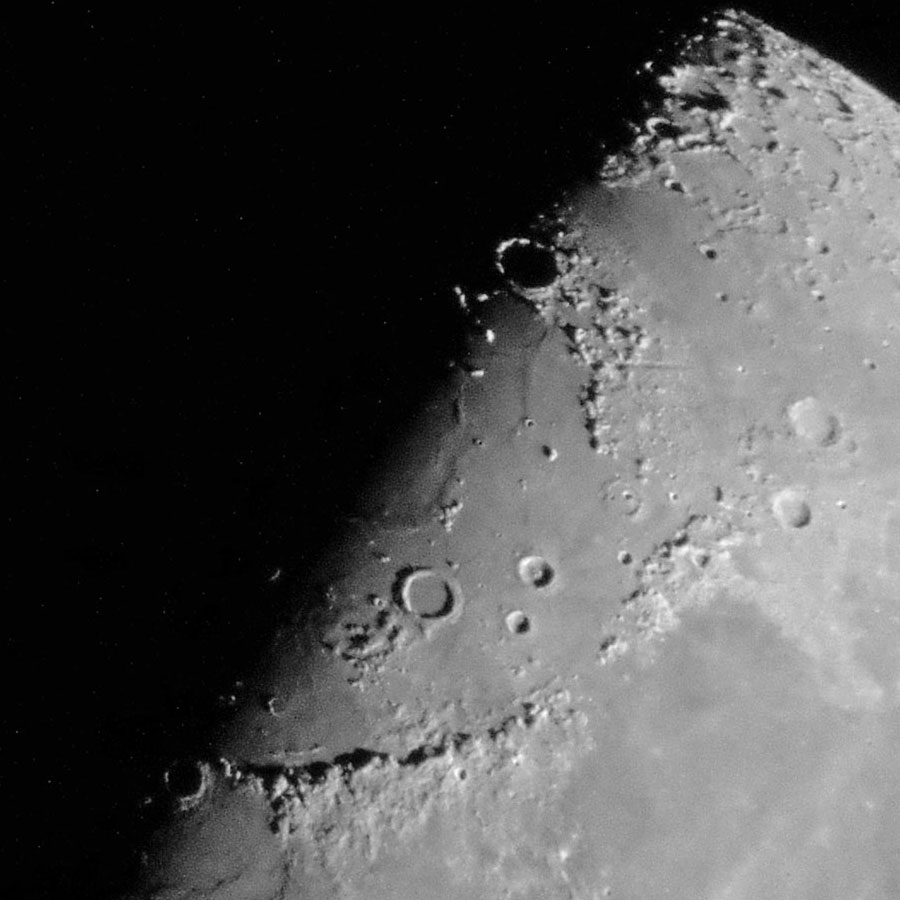 |
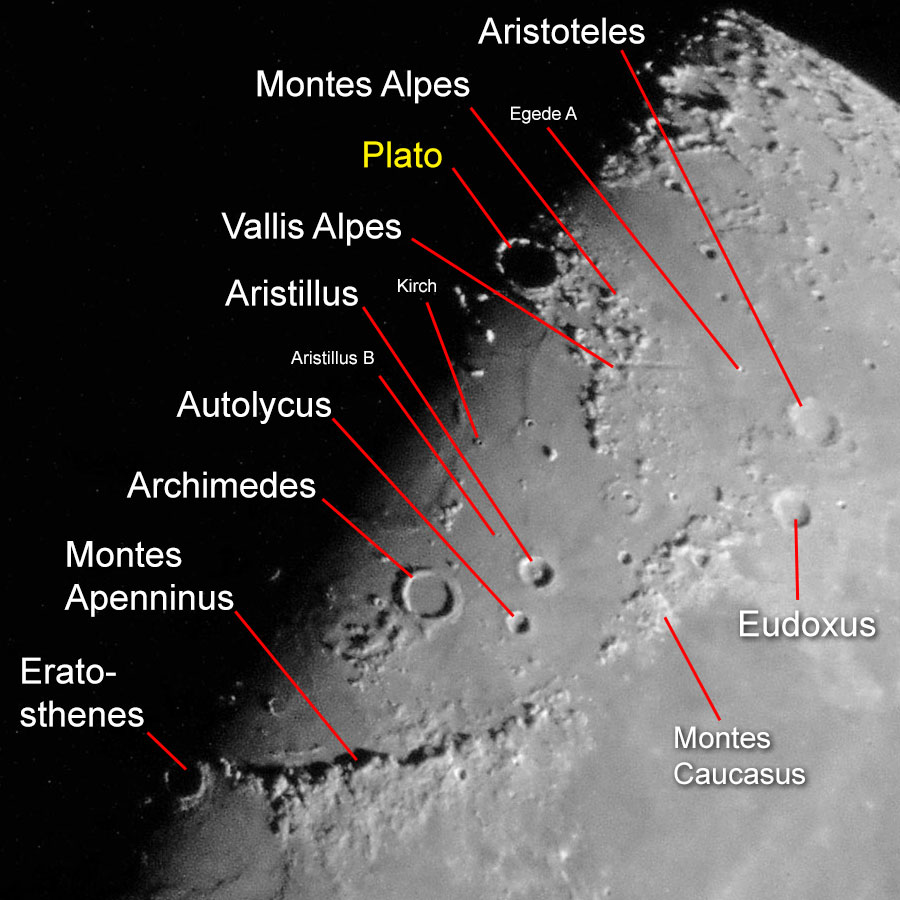 |
Photo data: February 23, 2018, Sky-Watcher Skymax-102 OTA, Ricoh GR held to the eyepiece
 |
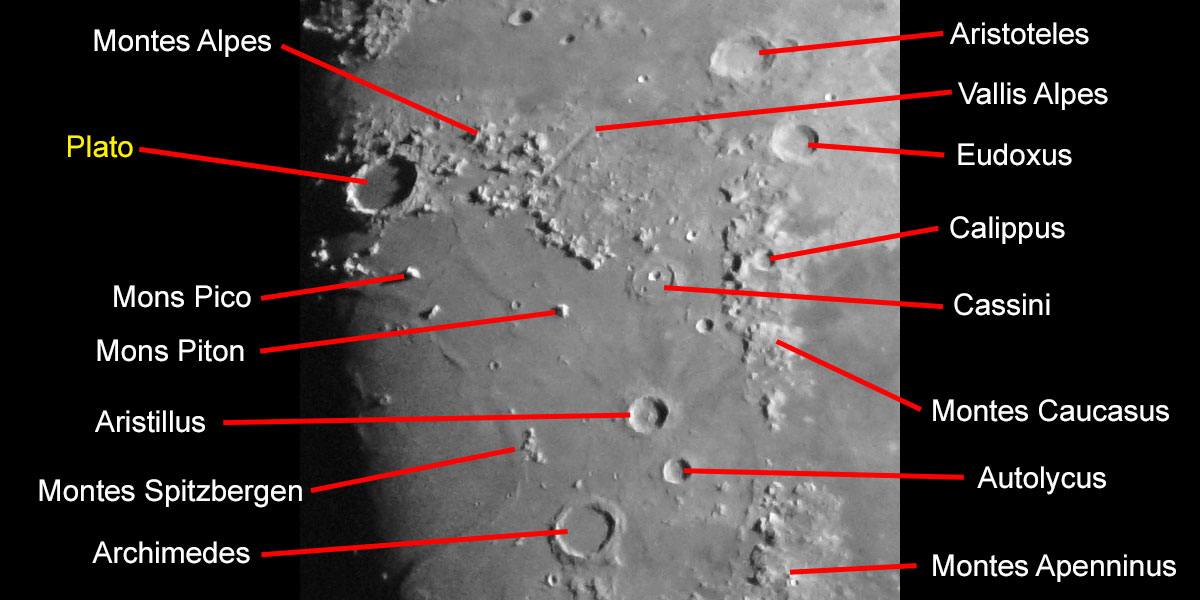 |
Photo data: March 25, 2018, Sky-Watcher Skymax-127 OTA, Sony RX100 M4 attached to the eyepiece
Posidonius
The walled plain Posidonius has a diameter of 100 km and is 1400 m deep (Spix; 96 km according to VMA); it is located at the northern edge of the Mare Serenitatis (Sea of Serenity).
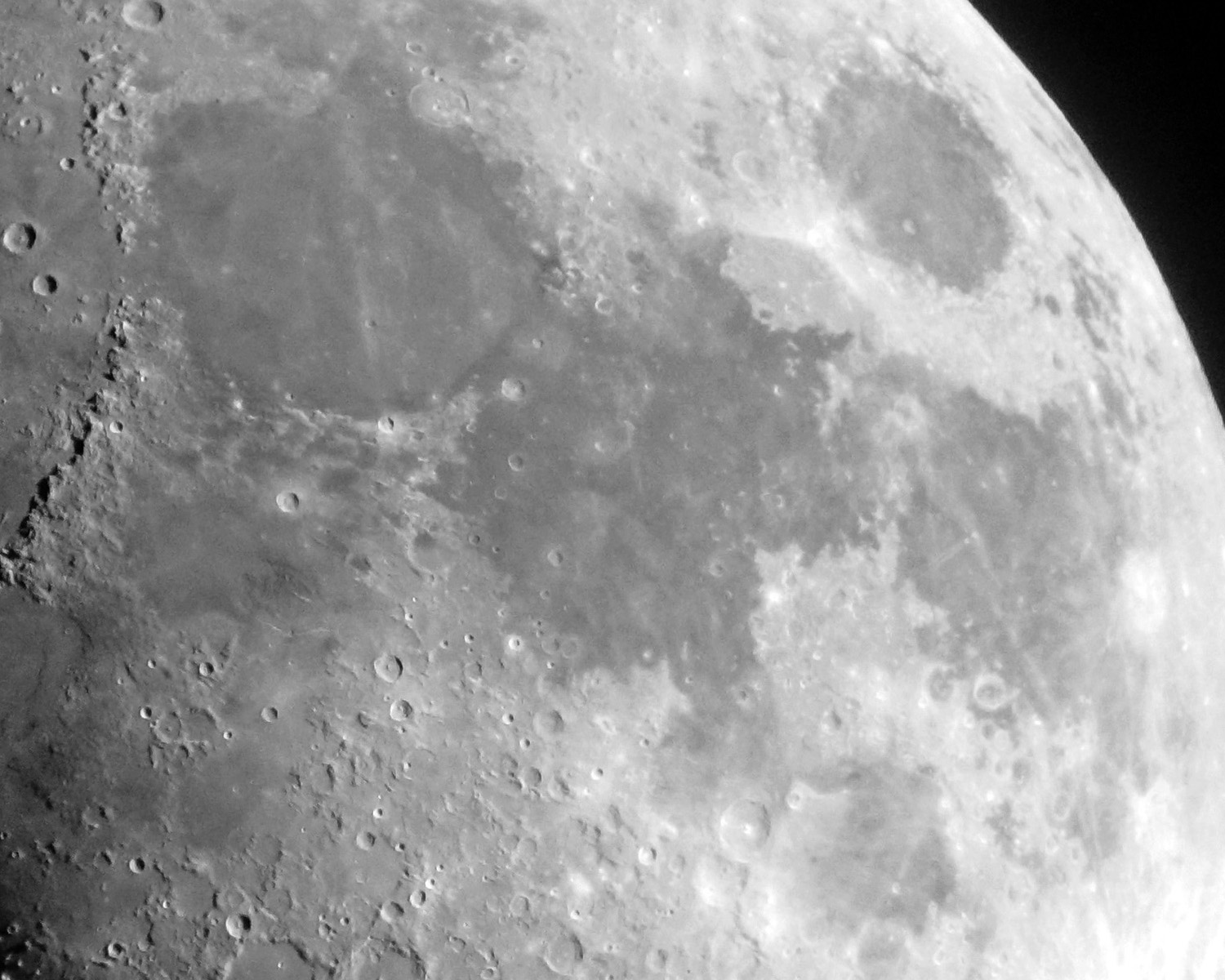 |
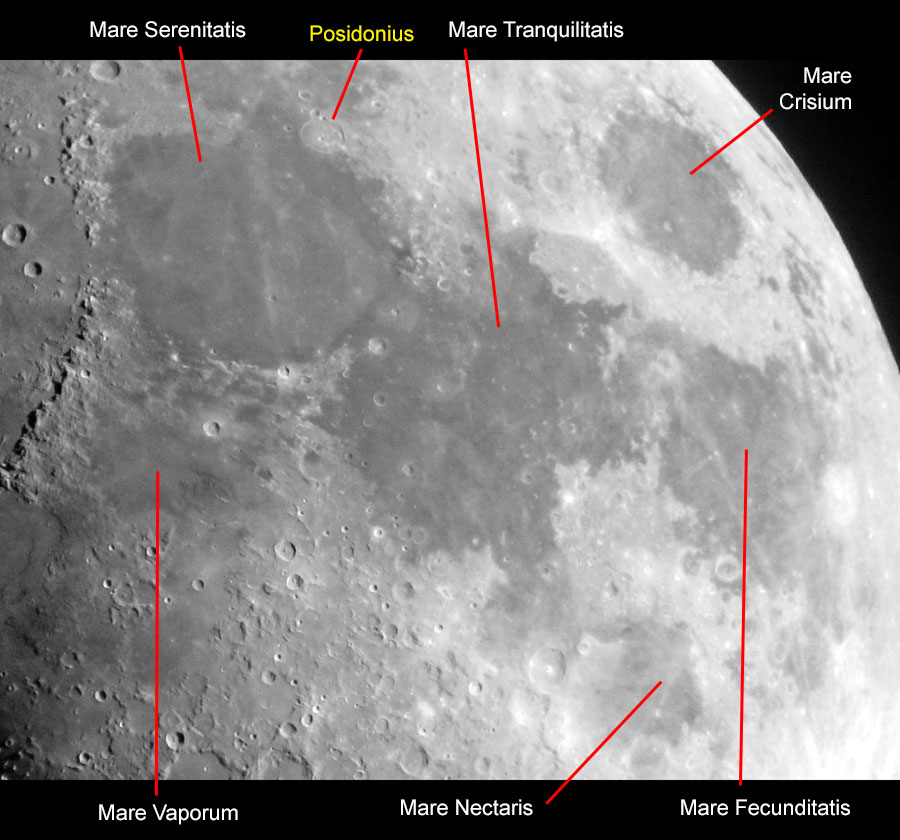 |
A section of the above photo:
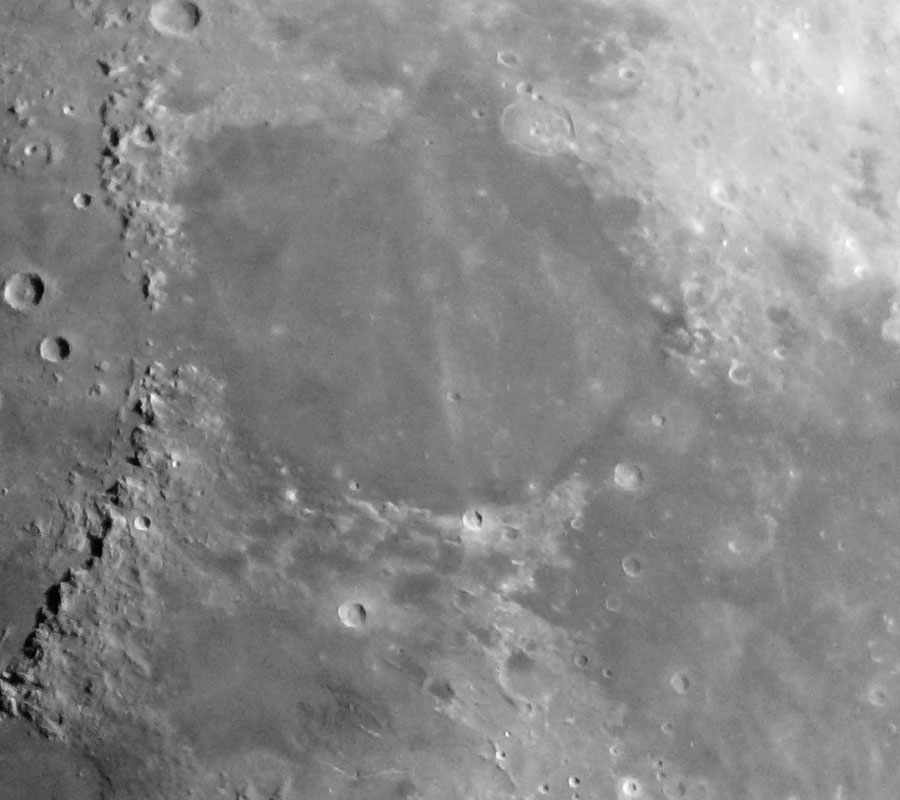 |
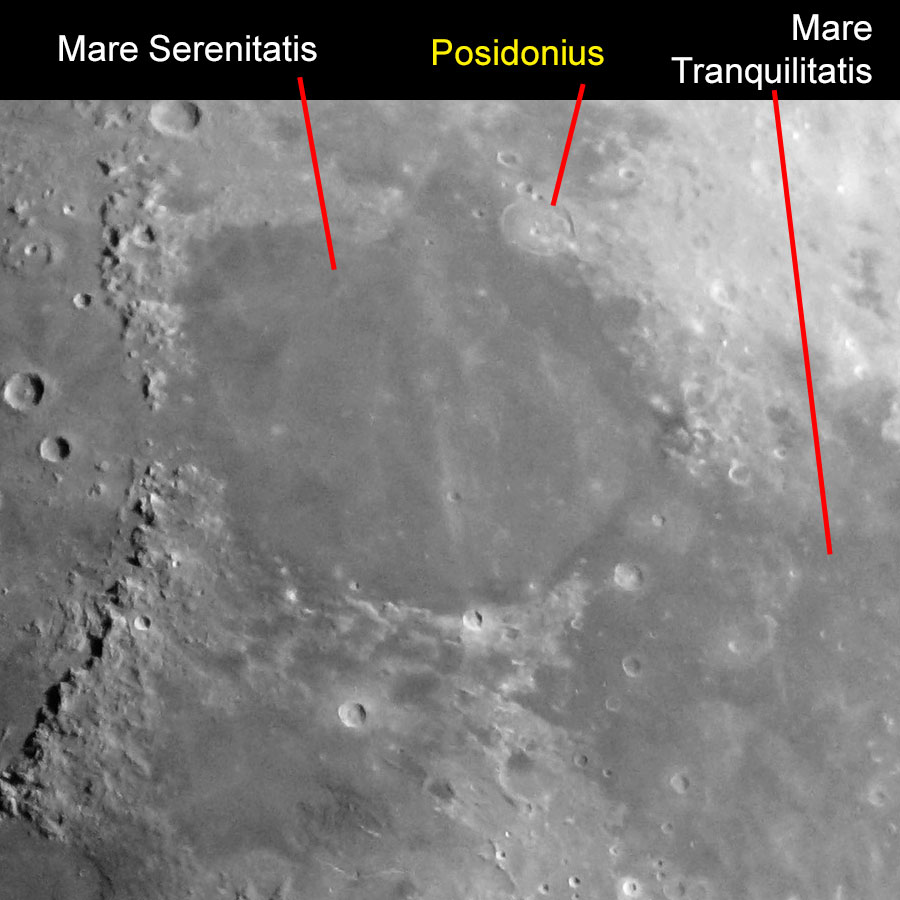 |
Photo data: March 25, 2018, Sky-Watcher Skymax-127 OTA, Sony RX100 M4 attached to the eyepiece
Procellarum, Oceanis (Ocean of Storms)
Oceanis Procellarum (Ocean of Storms) has a diameter of 2600 km (Spix) and therefore is the largest sea on the visible side of the moon.
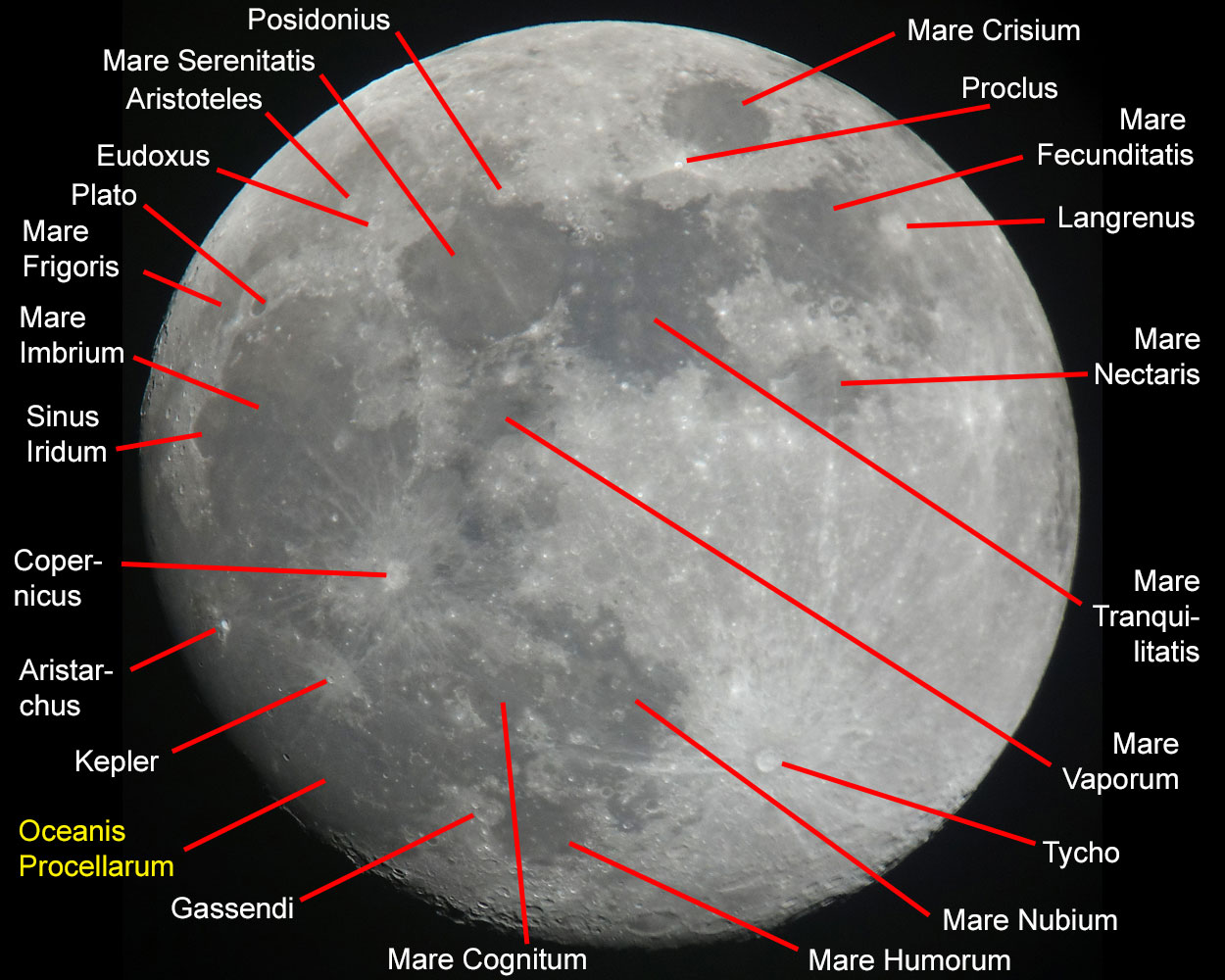 |
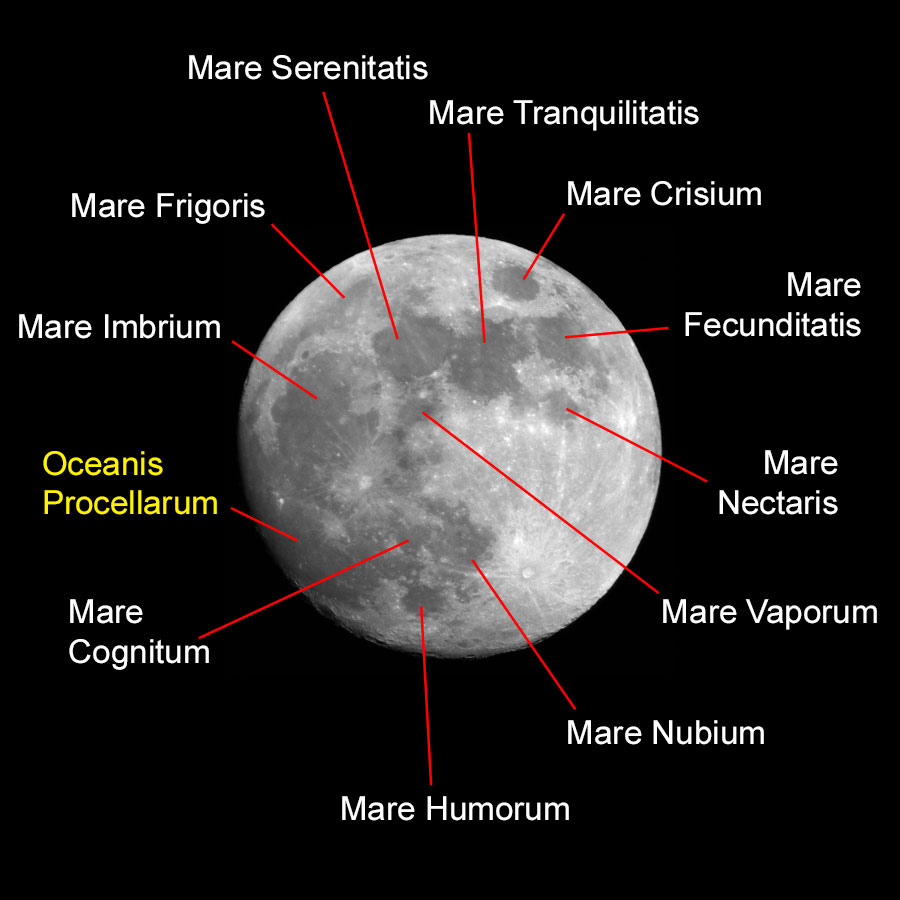 |
Photo data (left photo): March 29, 2018 (two days before Full Moon), Sky-Watcher
Skymax-127 OTA, Sony RX100 M4 attached to the 32 mm eyepiece
Photo data (right photo): February 28, 2010 (nearly Full Moon), Sky-Watcher
Skymax-127 OTA (probably), Leica X Vario (36 - 50 mm equiv.) held to a 32 mm
eyepiece (47 x)
Proclus
According to Spix, the small crater Proclus (28 km in diameter, 1900 m deep according to Spix; 28 km and 2400 km according to VMA) stands out due to its asymmetrically distributed ejected material; on the lowest photo one can perhaps catch a glimpse of this. Such a pattern occurs when the angle of impact is very flat.
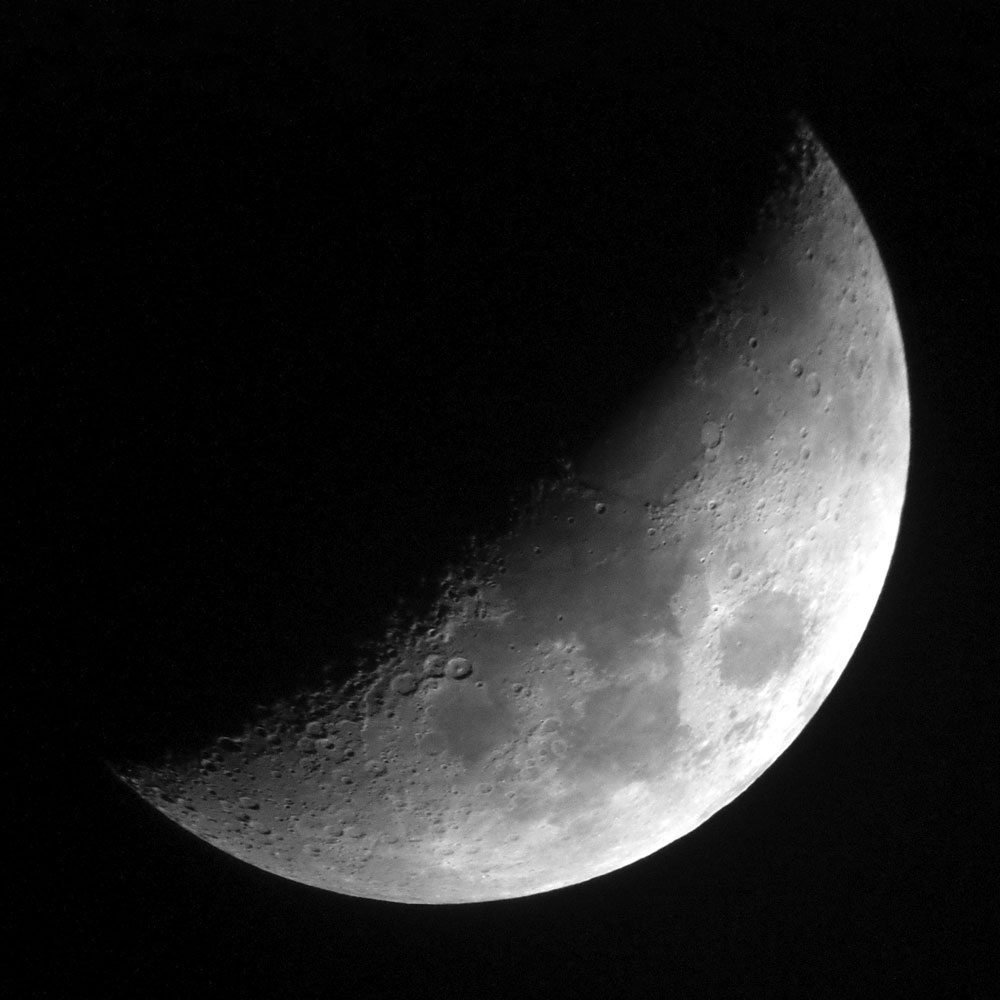 |
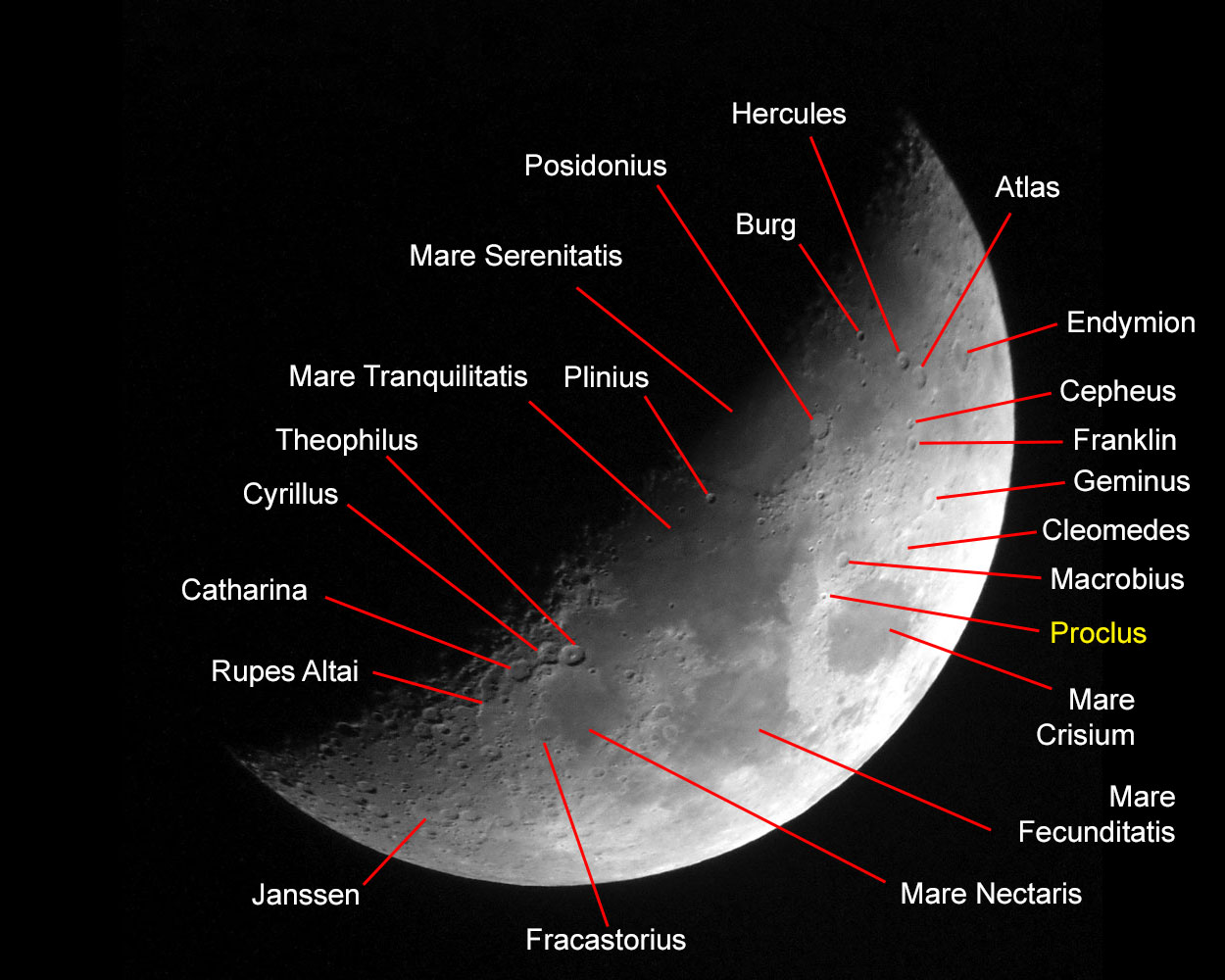 |
|
16 mm eyepiece |
||
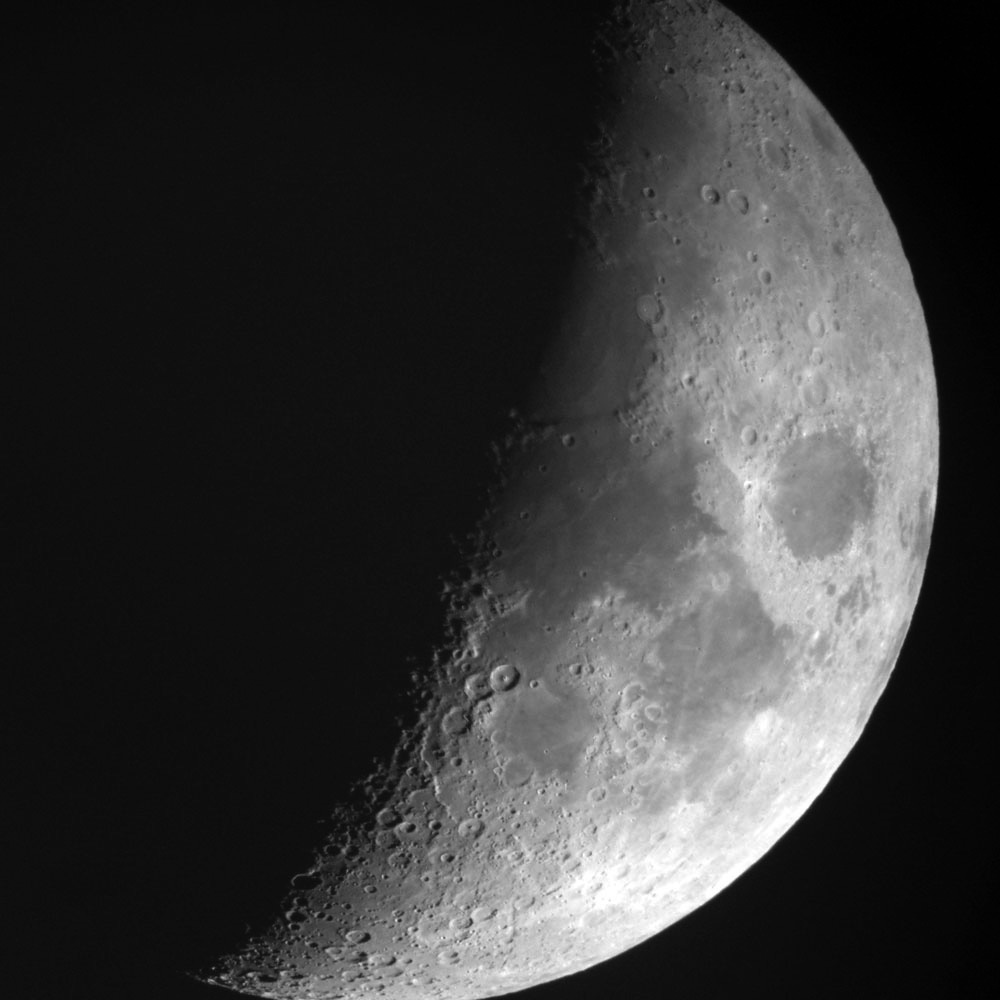 |
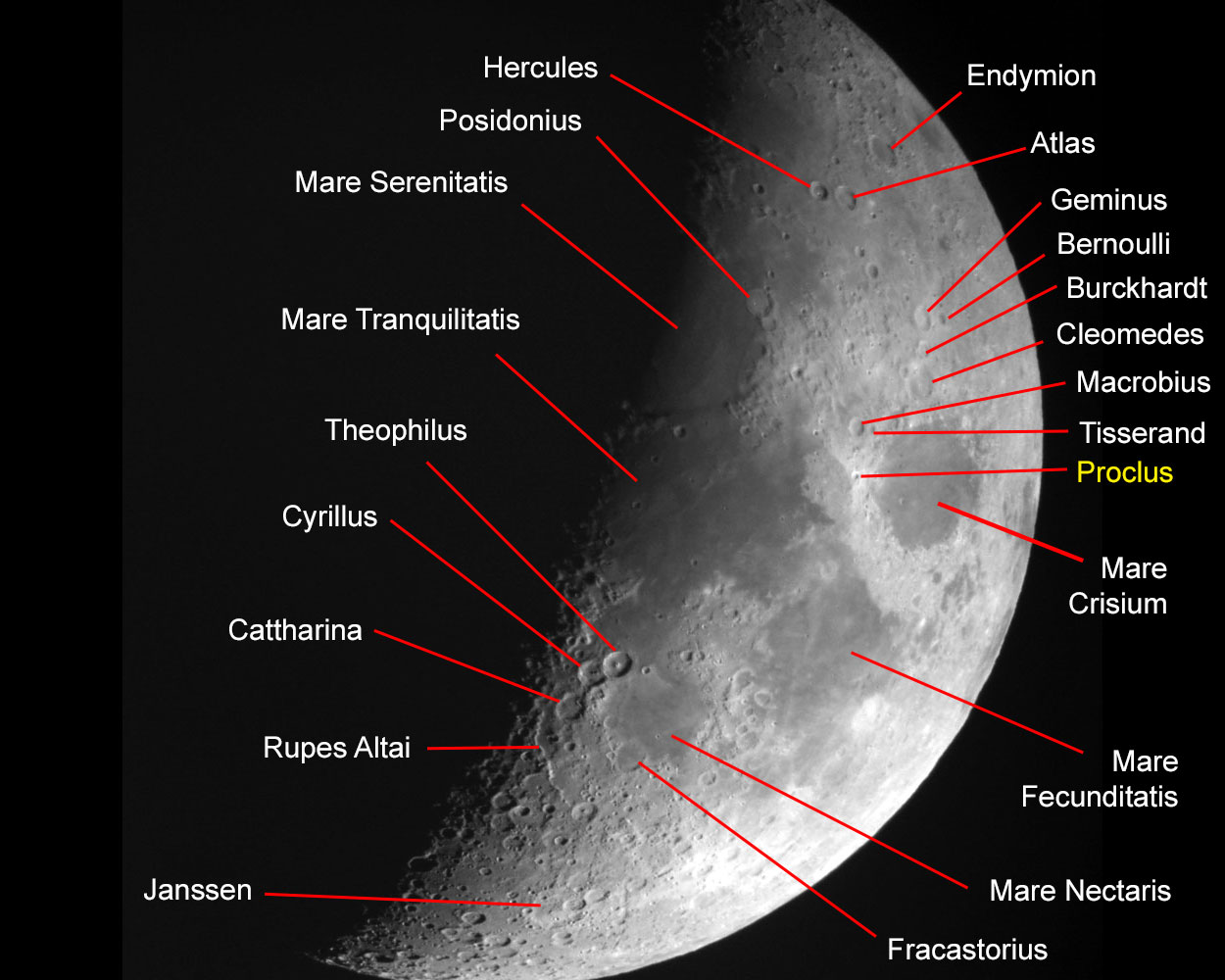 |
|
7 mm eyepiece |
Photo data: April 2, 2017, Sky-Watcher Explorer 150PDS-Teleskop, Ricoh GR held to the 7 mm or 16 mm UWA eyepiece
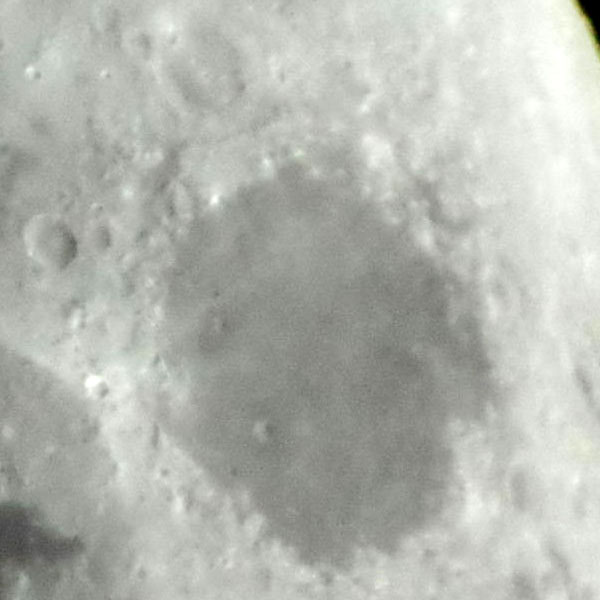 |
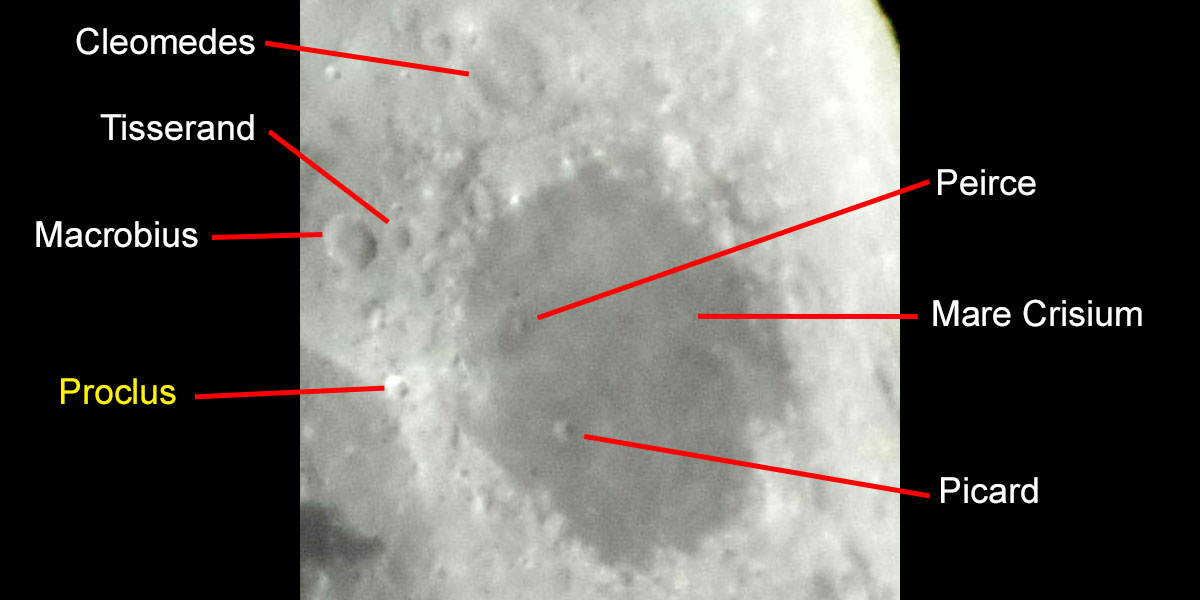 |
Photo data: May 2, 2017 (about Half Moon), Sky-Watcher Skymax-102 OTA, Ricoh GR held to the 7 mm UWA eyepiece (about 186 x)
Ptolemaeus
Walled plain (large crater) with a diameter of 153 km and a depth of 2400 m (Spix; 154 km according to the VMA). Located north of the craters Alphonsus and Arzachel; together, the three form a beautiful crater chain. To the right of Ptolemaeus, you will find the walled plain Albategnius.
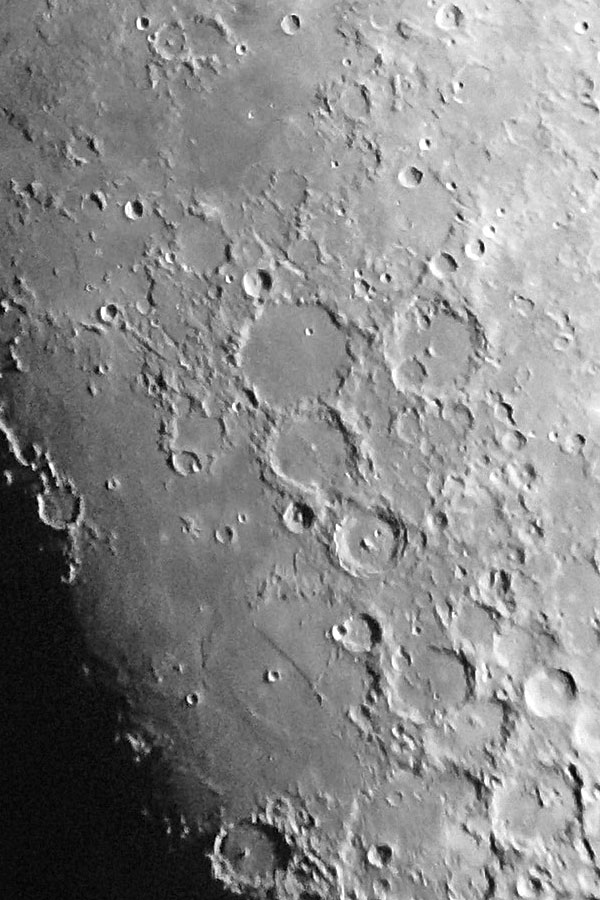 |
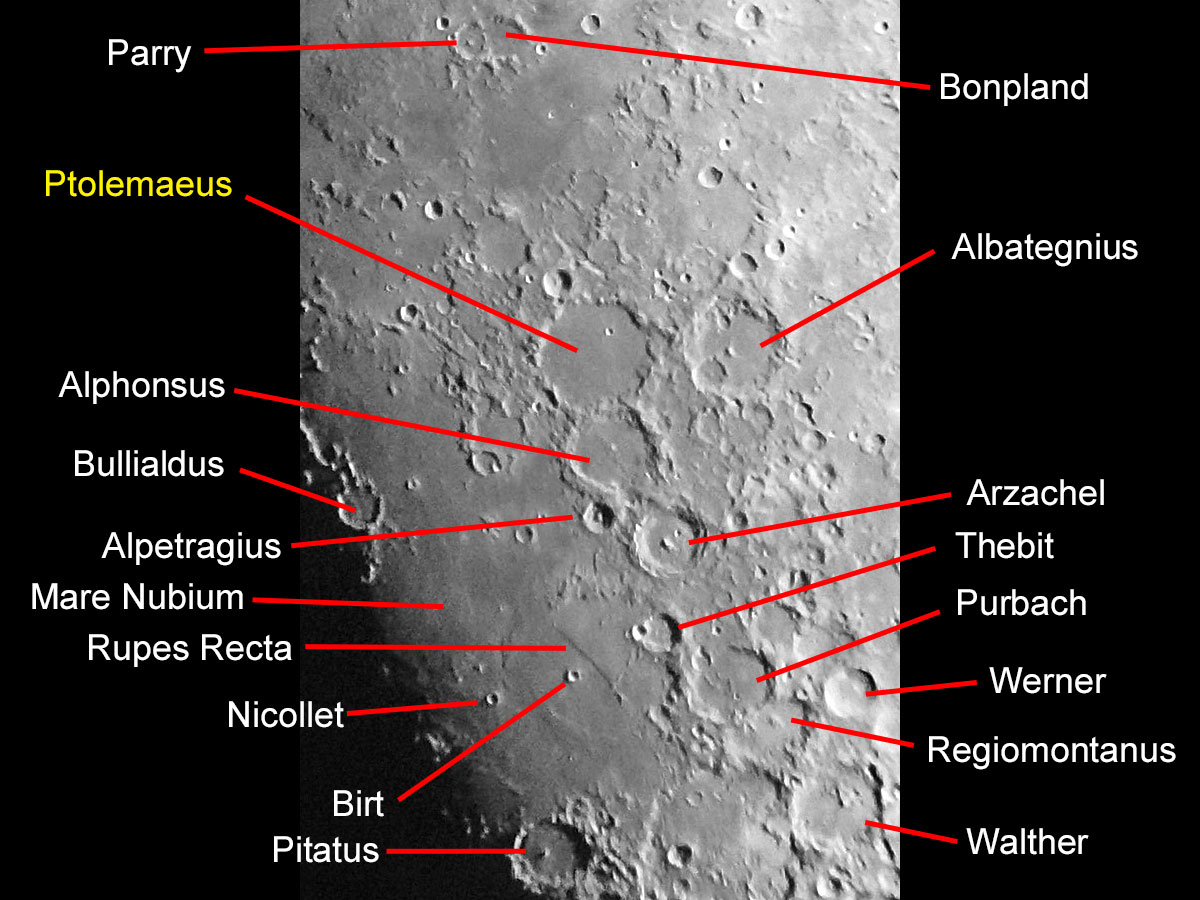 |
Photo data: March 25, 2018, Sky-Watcher Skymax-127 OTA, Sony RX100 M4 attached to the eyepiece
Purbach
The walled plain Purbach has a diameter of 118 km, is 2400 m high(VMA), and is located north of crater Regiomontanus.
 |
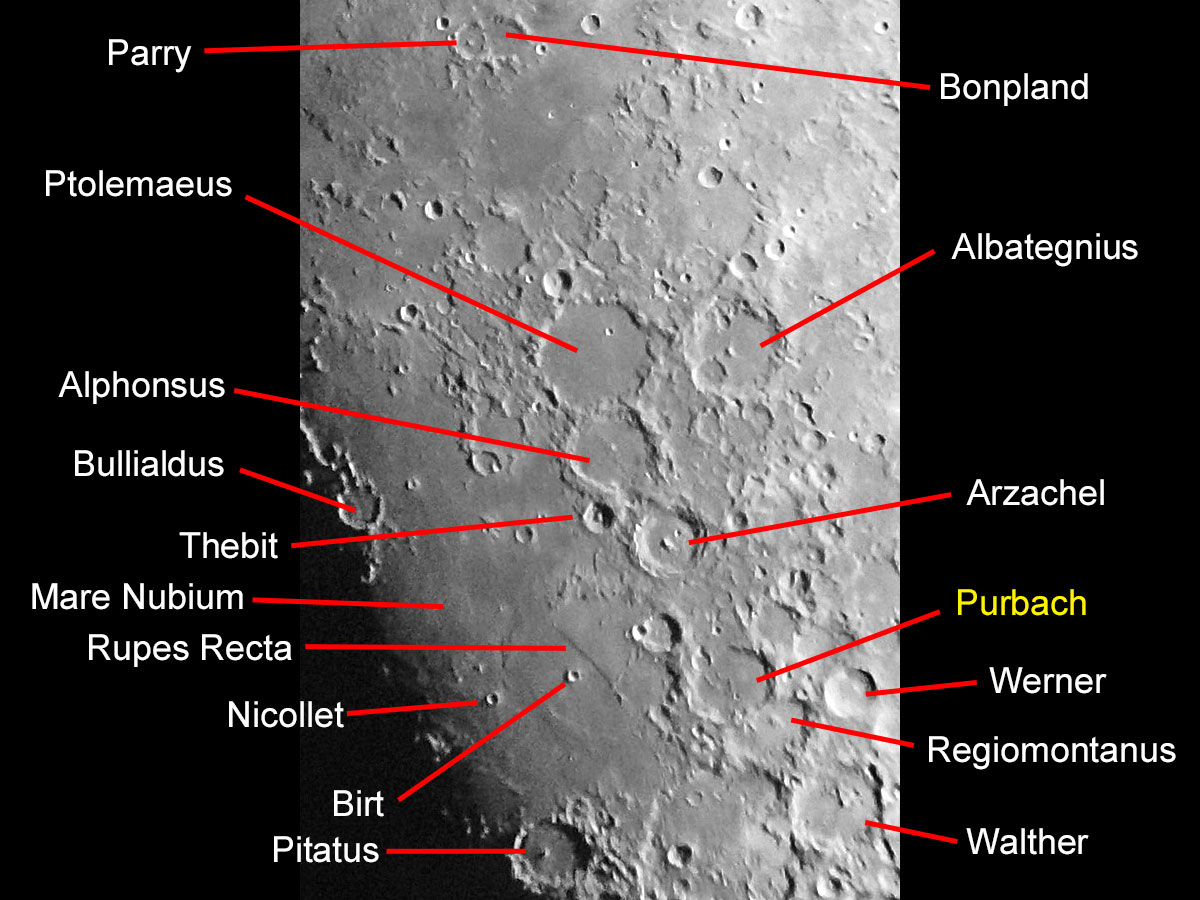 |
Photo data: March 25, 2018, Sky-Watcher Skymax-127 OTA, Sony RX100 M4 attached to the eyepiece
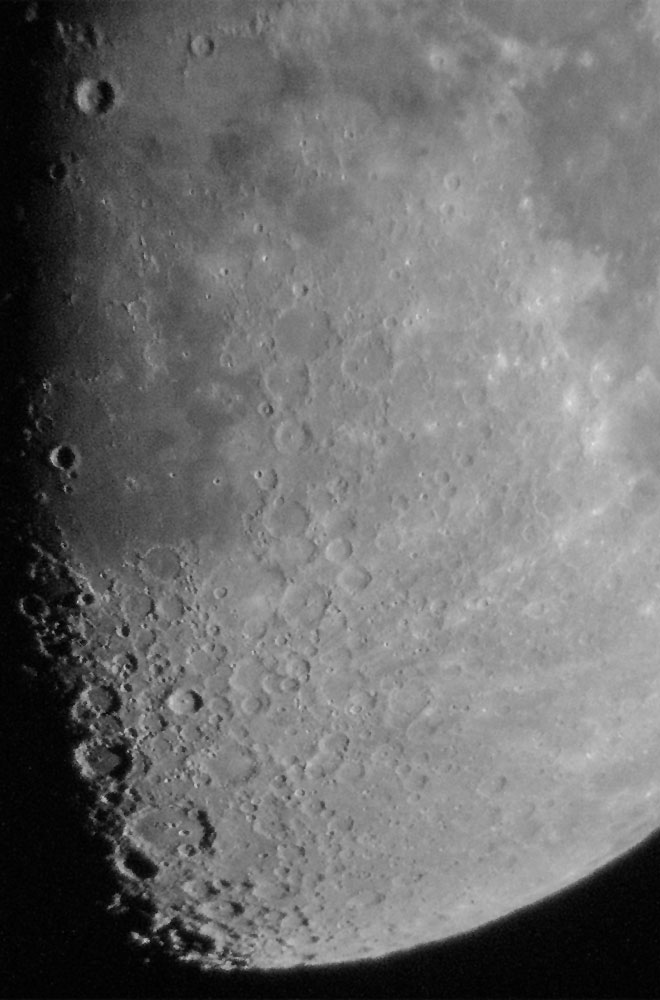 |
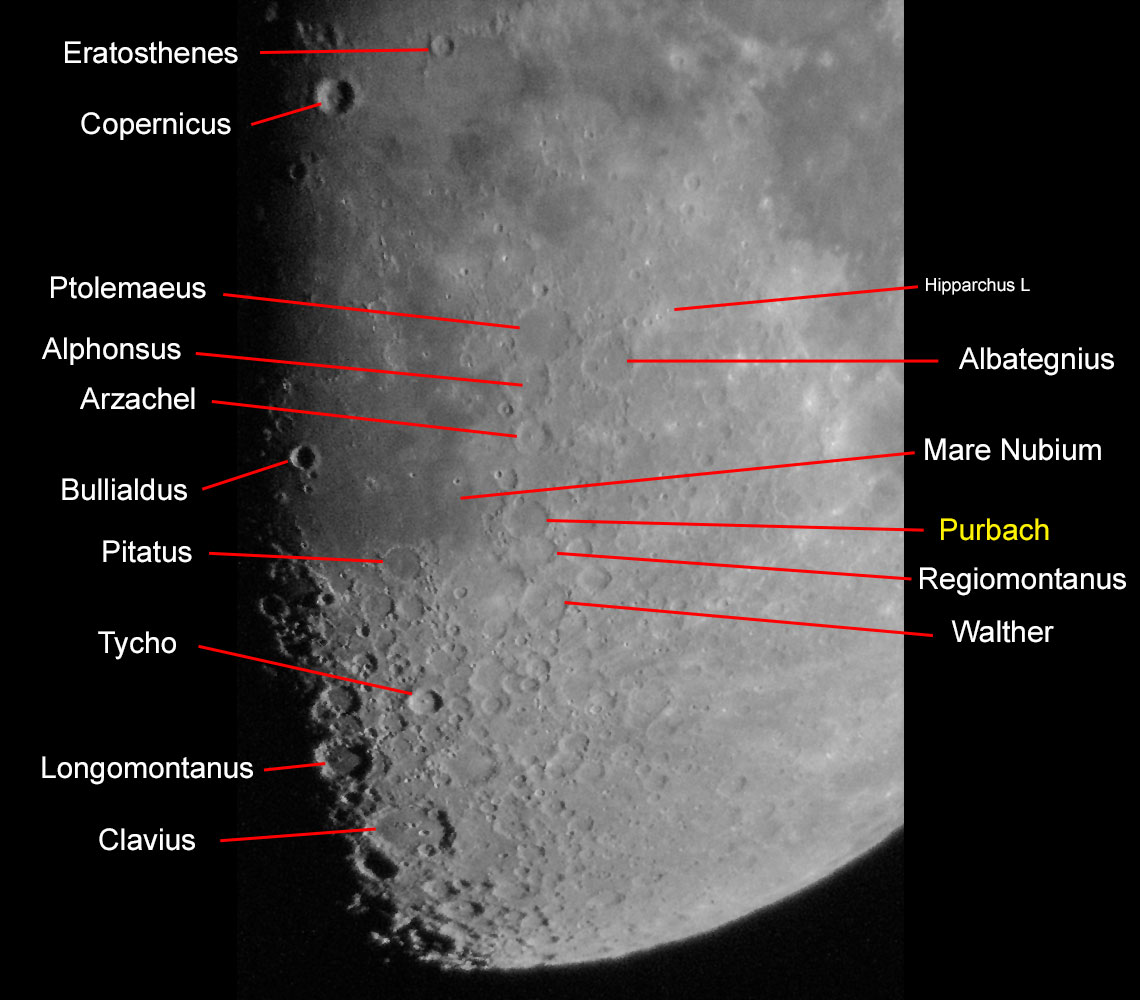 |
Photo data: July 2015, Sky-Watcher Heritage 100P telescope, Leica X Vario held to the 32 mm Digiscope eyepiece
Pythagoras
The ring mountains (large crater) Pythagoras has a diameter of 145 km and is 5200 m deep (Spix; 129 km and 4800 m high according to VMA); it is located at the northwestern edge of the moon.
 |
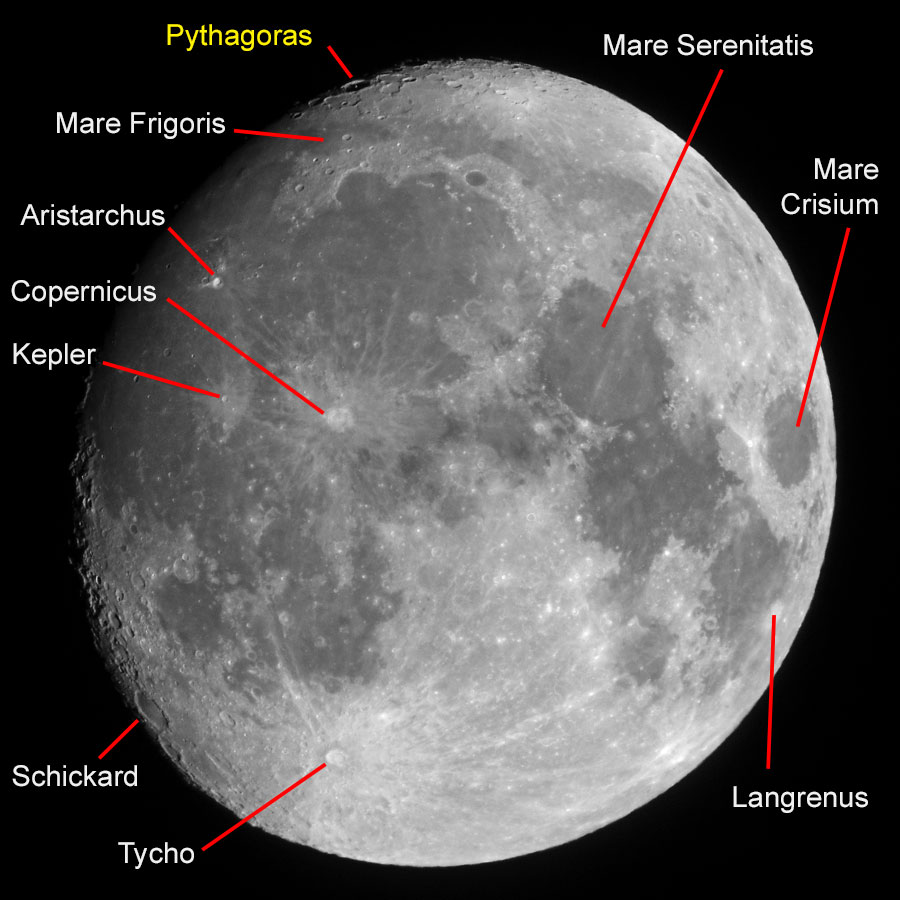 |
|
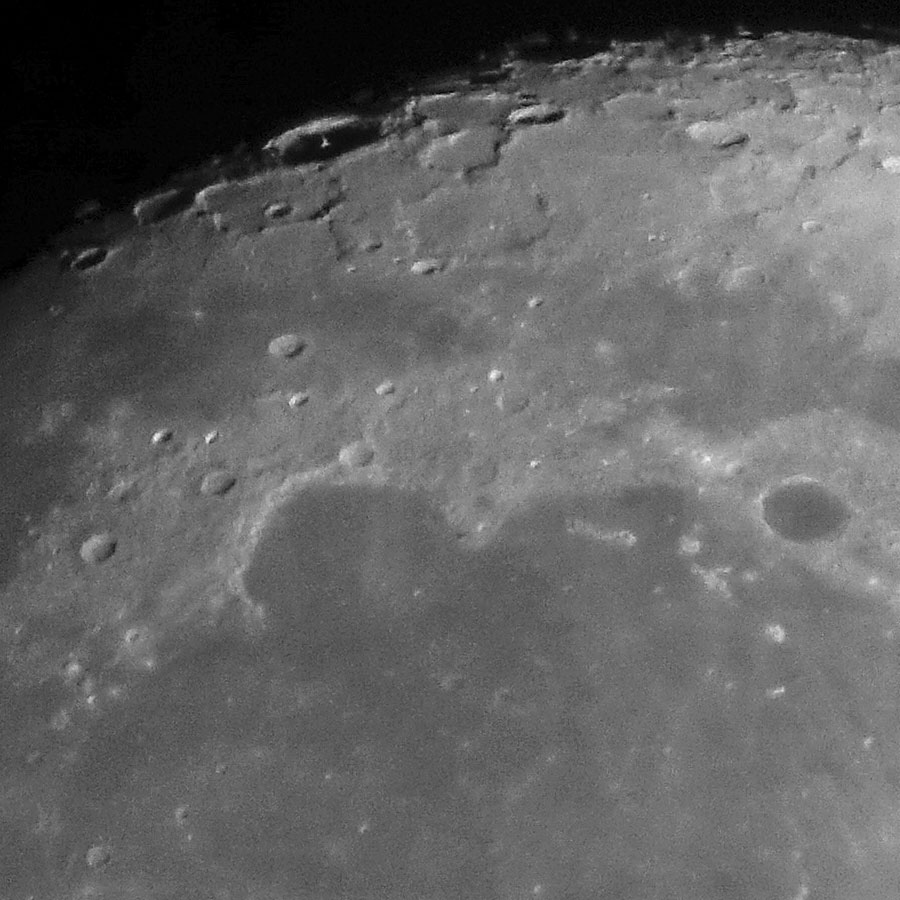 |
 |
Photo data: November 20, 2018, Omegon PS 73/432, Sony RX100 M4 attached to the 32 mm eyepiece plus 3 x focal extender
Q
...
R
Recta, Rupes (Straight Wall)
Rupes Recta is a linear fault on the moon, in the south-eastern part of the Mare Nubium. It can already be clearly seen in small telescopes in the grazing light of the half moon thanks to its shadow cast. It is 115 km long and 500 m high (Spix).
 |
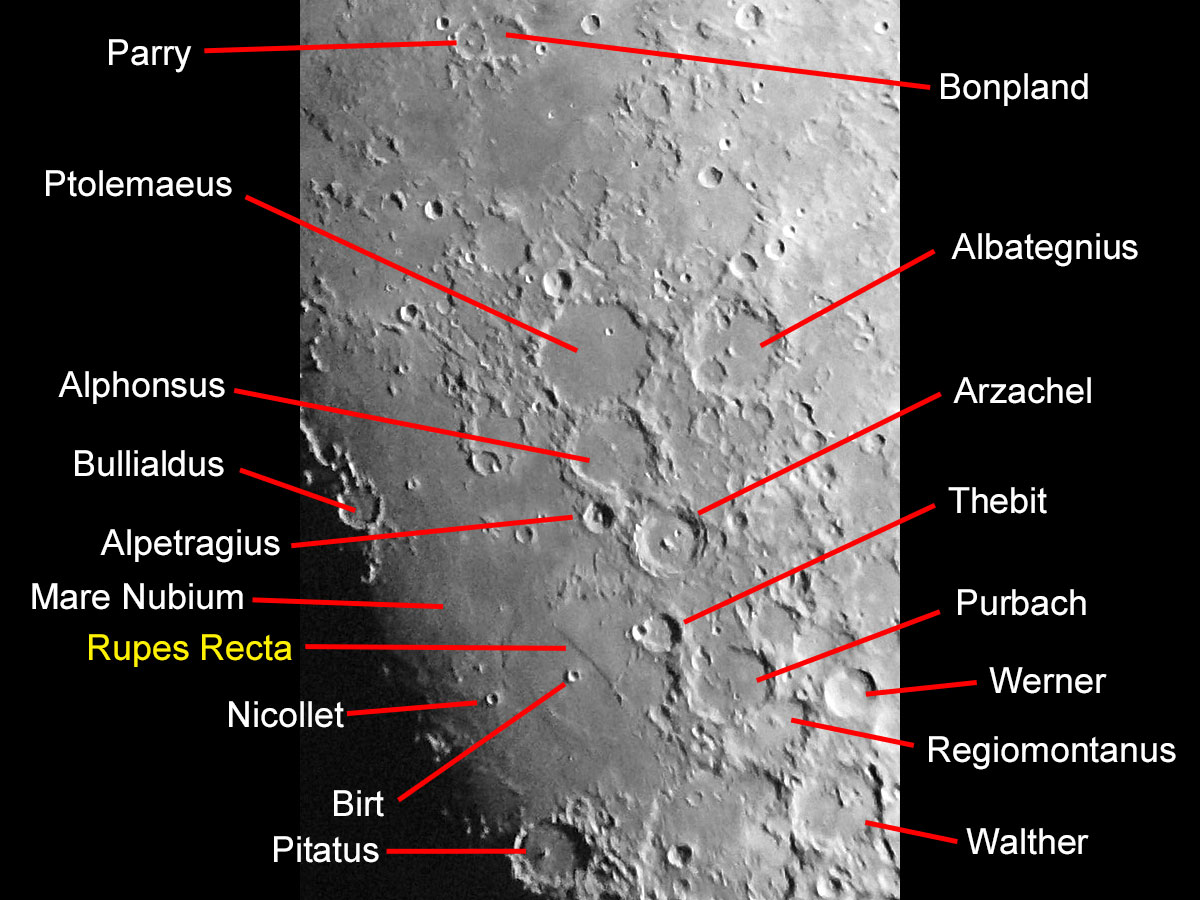 |
Photo data: March 25, 2018, Sky-Watcher Skymax-127 OTA, Sony RX100 M4 attached to the 32 mm-DigiScope eyepiece.
Regiomontanus
The walled plain Regiomontanus has a diameter of 126/110 km (VMA) and is located south of crater Purbach.
 |
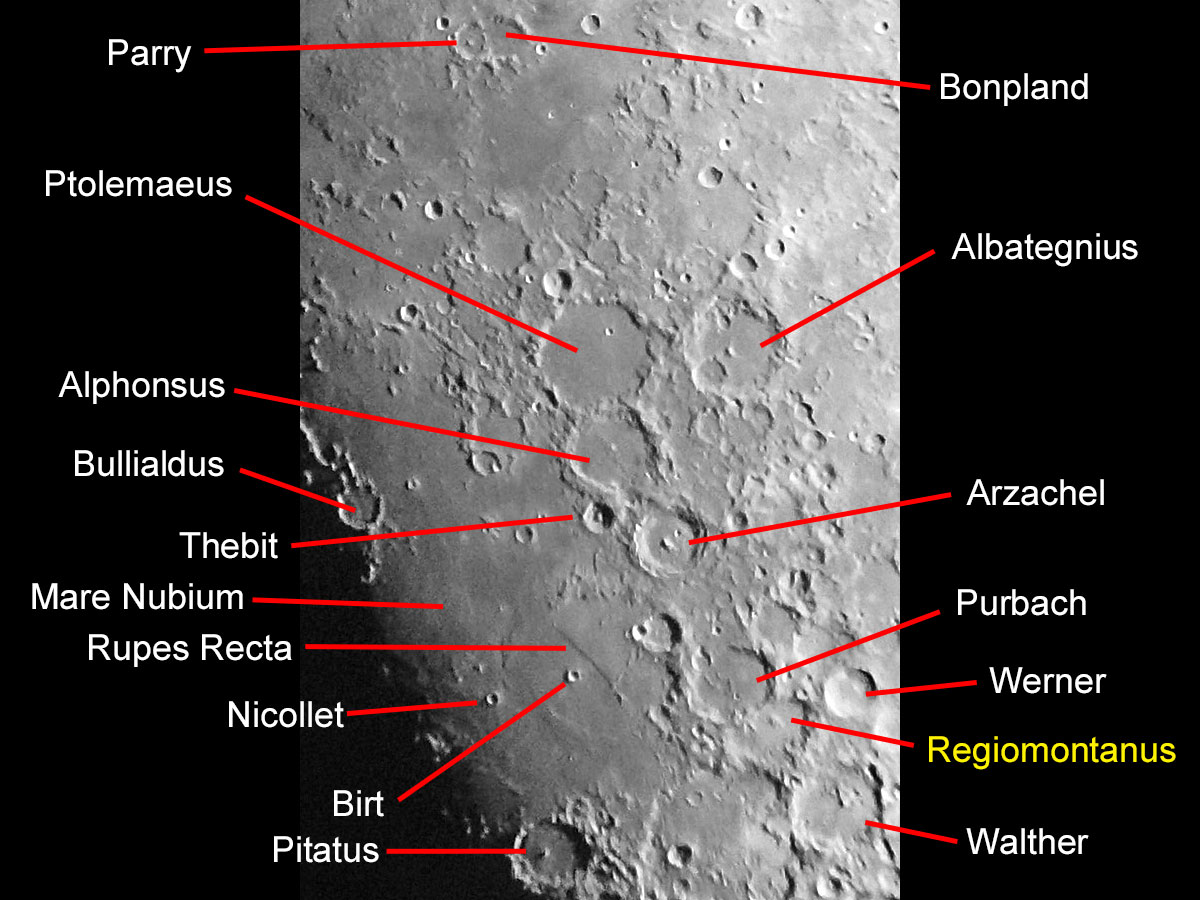 |
Photo data: March 25, 2018, Sky-Watcher Skymax-127 OTA, Sony RX100 M4 attached to the eyepiece
 |
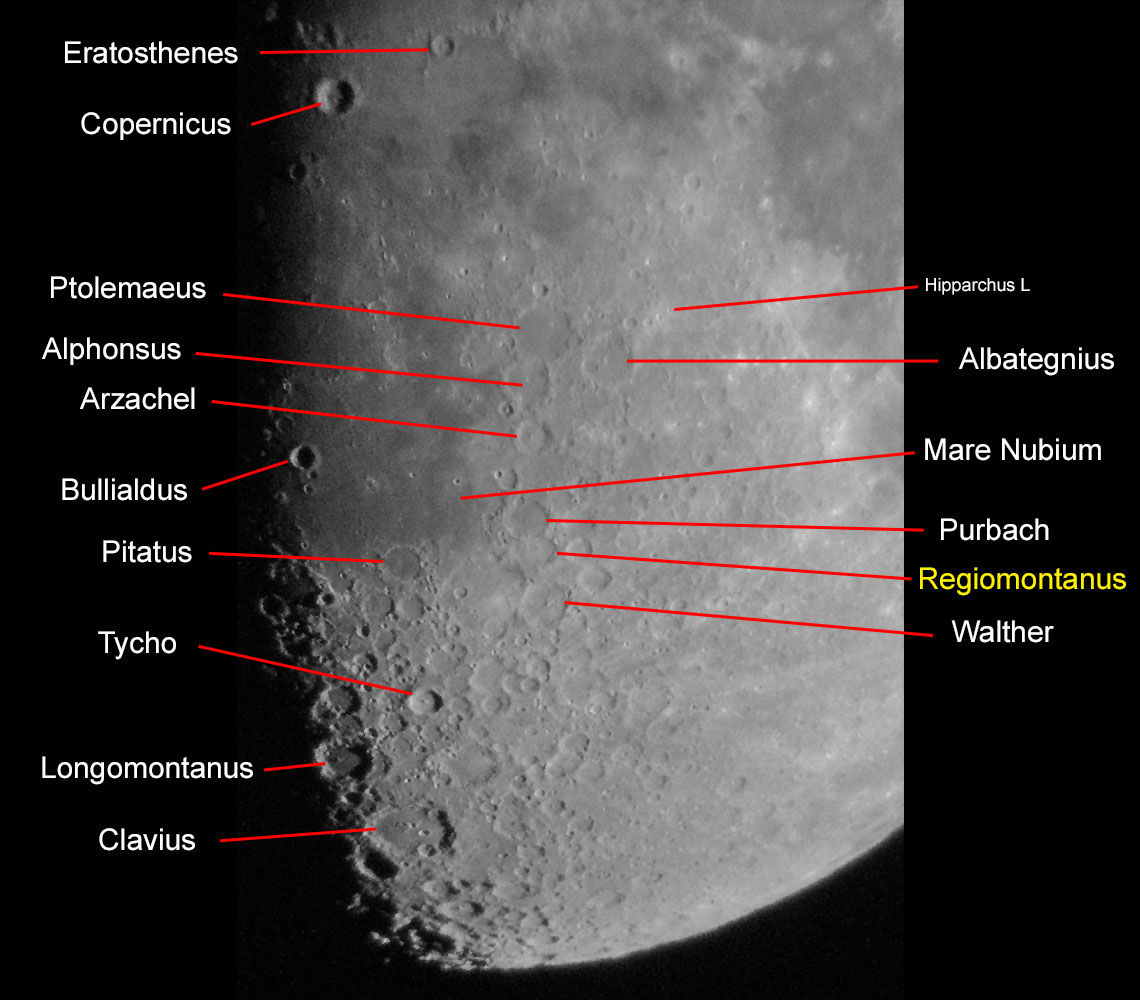 |
Photo data: July 2015, Sky-Watcher Heritage 100P telescope, Leica X Vario held to the 32 mm Digiscope eyepiece
References
- Mond (Wikipedia): de.wikipedia.org/wiki/Mond
- Moon (Wikipedia): en.wikipedia.org/wiki/Moon
- Lambert Spix (2013, 3. Auflage). moonscout - Mondmeere, Krater und Gebirge einfach finden und beobachten. Oculum-Verlag. ISBN 978-3-938469-58-3
- Lambert Spix & Frank Gasparini (2011, 1. Auflage). Der Moonhopper. Oculum-Verlag. ISBN 978-3-938469-54-5
- Ronald Stoyan, Hans-Georg Purucker (2013, 1. Auflage). Reiseatlas Mond. Oculum-Verlag. ISBN 978-3-938469-64-4
- Virtual Moon Atlas: ap-i.net/avl/en/start
| 19.11.2021 |